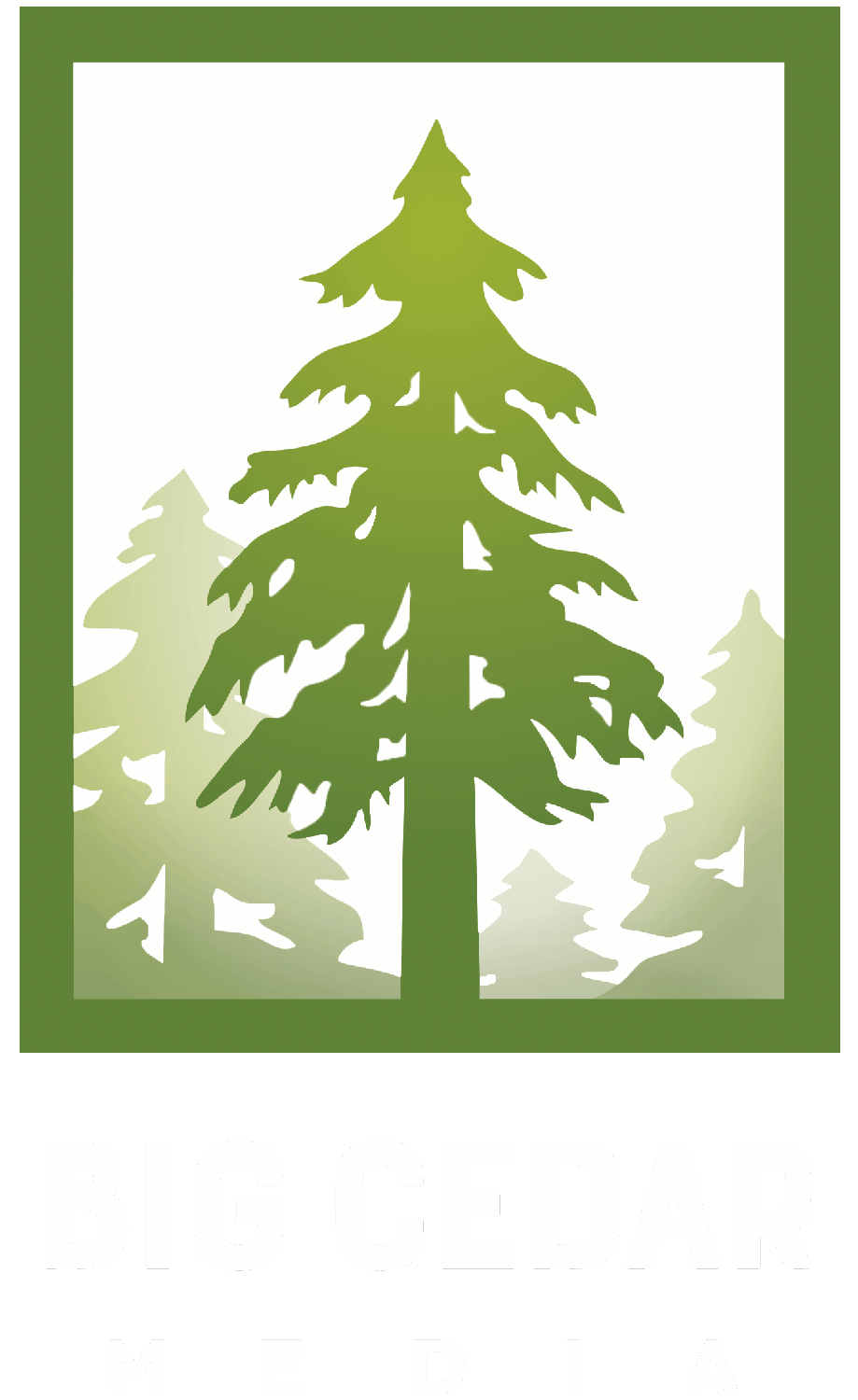🎥 Video Storyteller: Seeking Montana Businesses and Nonprofits for YouTube Retainer Partnerships
Montana is a place of incredible stories—from the passion behind our local businesses to the vital work of our non-profit organizations. But how do you get those stories out to the world in a way that truly captivates and connects? The answer is simple: consistent, high-quality video content on YouTube.
Montana is a place of incredible stories—from the passion behind our local businesses to the vital work of our non-profit organizations. But how do you get those stories out to the world in a way that truly captivates and connects?
The answer is simple: consistent, high-quality video content on YouTube.
I’m looking for a handful of Montana-based businesses and non-profits ready to take their YouTube Channels to the next level. I'm looking for a strategic short or long-term partnership (3, 6, & 12 Months) through a video production retainer—where I become your dedicated, in-house video team, focused entirely on growing your channel and amplifying your mission.
Why a YouTube Retainer is Your Next Big Move
You know you need video, but the stop-start nature of one-off projects is inefficient. A retainer flips that model, offering you:
🎬 Consistency is Key: YouTube rewards consistency. A retainer guarantees you a predictable, scheduled flow of fresh content every month. No more scrambling to find a crew or missing important publishing dates.
🤝 A True Partner: I don't just execute orders; I become intimately familiar with your brand, audience, and goals. This leads to video content that is strategically aligned, consistently branded, and truly effective.
💰 Predictable Budgeting: Say goodbye to project-based surprises. A set monthly investment allows for clear, predictable budgeting of your content marketing.
🚀 Exponential Growth: Consistency combined with strategy is the fuel for YouTube channel growth. We'll work together to optimize your videos for discovery, build playlists, and keep your audience coming back for more.
From Documentary Filmmaker to Your Content Creator
My background isn't in generic corporate video—it's in documentary filmmaking. This means I’m trained to do one thing exceptionally well: find and tell authentic, compelling stories.
This expertise is a massive advantage for your YouTube channel:
Brand Storytelling: I can create cinematic "About Us" videos, “Origin Stories,” and employee or owner “Spotlight videos.” Mini-docs (3-5 minutes) such as, an ongoing “Day in the Life Of” video series can entertain and build trust. These videos can show the why behind your organization, not just the what.
Deep-Dive Education (The "How-To"): Documentary techniques excel at breaking down complex topics. I can turn your expert knowledge into engaging tutorials, explainer videos, and case studies that establish your authority.
Testimonials That Resonate: Forget the stiff interview. I capture real, emotional testimonials and client stories that feel authentic and powerful, driving genuine connection.
Editing Your Camera Phone Videos: You’re at your job everyday and most likely have a camera phone in your pocket. If you like to shoot videos of your day to day operations and do selfie interviews I can take that footage and edit it into a compelling story for YouTube Shorts or Instagram Reels.
Whether you need a 60-second social clip, a 10-minute interview with a community leader, a product demo, or a beautiful cinematic overview of your operations in the Montana landscape, a documentary approach provides the skills to capture and craft it all.
Each business and non-profit has different video story potential but what it means for everyone is a library of content that builds brand authority, educates customers, entertains, and ultimately, drives sales.
Ready to Elevate Your Montana Story?
If you are a Montana business or non-profit that is serious about leveraging video storytelling and YouTube to connect with your audience and grow your impact, let's talk.
I’m looking for a select number of retainer partnerships that align with my mission and brand at Big Cedar Media. I'm looking for partners ready to commit to a long-term strategy and consistent video output.
Interested in exploring a video retainer partnership?
Please click the button below and reach out.
Time-Lapses: 3 Reasons Why Montana Builders Should Use A Construction Camera On Their Next Project.
Time-lapse photography showcased in a short 20-30 second video shows growth, professionalism, completion, and success. People online love to watch time-laspes as it is satisfying to see a building, roadway, or bridge being assembled in a short sped up video.
Time-lapse photography showcased in a short 20-30 second video shows growth, professionalism, completion, and success. People online love to watch time-laspes as it is satisfying to see a building, roadway, or bridge being assembled in a short sped up video.
Time-Lapse Construction Camera Companies
There are many different time-lapse construction camera companies online with each offering various selling points. All of the outdoor time-lapse cameras offer a weather proof housing with some offering solar panel charging options and others need to be plugged in to a power source. The cameras range in megapixel quality, as well as, how often they take a picture. Most of the top time-lapse camera companies offer an online hosting platform to view and save the most recent photos taken, as well as, view livestreams of the job site 24/7. Some of the companies can alert you if something is not working in the camera and others will even create a final time-lapse video for you to use at the end of the building project.
Many of the above features make for a rather pricey time-lapse video that range anywhere from $6,500 - $17,500 for the physical camera cost and 12 month online hosting cost. And then you have to set everything up yourself. With so many offerings it can be tough to narrow in on one camera that serves all your needs. That’s where Big Cedar Media’s construction time-lapse camera services comes in.
Big Cedar Media Montana construction timelapse video example.
Big Cedar Media’s Time-lapse Services
Seth Dahl of Big Cedar Media has researched many of the leading time-lapse camera companies and narrowed in on a couple brands that offer the best online services, picture quality, and solar panel power capability. Seth can mount the camera on location assuring the camera is not going to be set in a bad location or improper height or angle. Seth can set the camera up to take photos every 10 minutes (or longer or shorter) depending on the estimated build time for the project and what is being built. Throughout the duration of the project Seth will insure that everything is working properly and will work with the camera company to resolve any issues that arise. At the end of the building project Seth will process the high quality photos, assemble the photos into a 20 second - 1 minute time-lapse video, add music & your company logo, and export a high quality final video for your immediate advertising use.
All the builder ends up paying Big Cedar Media for is the time-lapse camera rental and install fee, Seth’s time monitoring the time-lapse, and editing costs. Additionally the builder would pay for the monthly online hosting service. Working with Big Cedar Media for your next Montana building project time-lapse keeps your costs way down compared to buying or renting everything from a camera company. Also Big Cedar Media takes the headache out of having to manage the camera throughout the duration of the construction project.
3 Reasons
3 reasons why Montana builders should use a time-lapse construction camera on their next project are:
Monitor. Online hosting platforms allow general contractor project managers and home owners the ability to view and monitor the building site in real time, 24/7.
Track. Online hosting platforms allow for time-lapse teasers to be assembled and shared with your investors or owners showing the project progress. Also this assures that the camera is working and photos are being saved throughout the duration of the build.
Promote. A final time-lapse online marketing video of your building being assembled will wow your stakeholders and investors and be a great way to highlight a project and advertise your business.
Big Cedar Media films construction and building projects.
Montana Growth and Development
All of Montana is growing so quickly, especially Bozeman, Big Sky, Kalispell, Whitefish, Missoula, Helena, and Billings. Businesses that could use time-lapse photography in their marketing are; general contractors, subcontractors, builders, construction companies, developers, road builders, surveyors, architects, designers, home owners, and civil & structural engineers. Any construction process that shows growth or change of how something was before and how it looks after it is completed make great time-lapse videos.
Additional Big Cedar Media Marketing Video Services
Let Big Cedar Media take care of all your time-lapse video needs. Additionally, Big Cedar Media can take your marketing videos a step further with story based promotional videos for your business. Seth will capture additional high quality camera and drone footage of your building being built. The end results are narrative marketing videos that range from 30 seconds to 2 minutes in length and follow a problem, solution, success format. These catchy videos give a personality to your business and can follow the founder, team members, employees, and clients in short testimonial videos.
Big Cedar Media “Business Legacy Film” example.
3-5 minute “Builder Legacy Films” dive deeper into your story and aim to leave the audience with your lasting legacy in your area of work. They follow more in depth how your Montana construction company got started, problems faced along the way, where your company is at now, and what the future holds. Interviews with the founders, workers, or project managers give a personal voice to the business or a voice over artist can be hired to read a script. These films showcase your beautiful work through creative story telling that entertains, enlightens, and engages your online audience.
Please reach out to Seth Dahl of Big Cedar Media to find out more about his time-lapse services or marketing video services.
Are you a Bozeman, montana Business who needs video marketing?
One of the problems your business might struggle with is conveying your online video story in a truthful and effective way. Your online audience wants to know exactly what you offer and if it will improve their lives. If they aren’t engaged by the video or don’t understand what you offer they will move on to another service or product who is being more clear in their marketing.
One of the problems your business might struggle with is conveying your online video story in a truthful and effective way. Your online audience wants to know exactly what you offer and if it will improve their lives. If they aren’t engaged by the video or don’t understand what you offer they will move on to another service or product who is being more clear in their marketing.
Good story telling is the solution to this problem but not all video production is the same. Some video production companies rely too heavily on just pretty pictures to tell the story while other video ad agencies produce videos too quickly, ultimately lacking a good story. These videos fail to create that important emotional connection between you and your customers.
Online video marketing stories should be felt instead of just seen and that’s what Big Cedar Media’s Problem, Solution, Success business marketing videos offer. This type of advertising video presents the problem your business combats, positions your business as the solution to that problem, and leaves the viewers with what success looks like after the problem has been resolved.
Example of Big Cedar Media’s Founder Videos that cover the Problem, Solution, Success format.
These narrative based marketing videos use classic story structure to engage, entertain, and enlighten people in a thoughtful, creative and concise way. A successful video engages your audience with good story telling that resonates, gives them a clear picture of how you solve people’s problems, and starts to create that important genuine human connection to people online.
It’s a simple process to produce these short videos. Seth Dahl of Big Cedar Media simply spends part of a day with you at work capturing engaging, non intrusive, visual content as it unfolds in your regular work day. He then interviews you to use as a voice over in the final video. This nonfiction advertising style of video production doesn’t require actors, sets, or extensive shooting or planning and when done right offers rich, authentic moments that draw people into the story.
Big Cedar Media offers numerous Problem, Solution, Success videos for your Montana business. Founder Videos follow one or more business founders at work with a final edited video being 2 minutes or under in length. Team Videos follow 1-3 Employees at work in 2 minutes or under. Employee Videos follow one employee at work in 1 minute or less. 30-40 second Client Testimonials can be a powerful way give credit to your Montana small business when your favorite clients rave about your product or service and how it bettered their life. Additionally, Seth Dahl can shoot documentary style still photos of your work in action to be used in email marketing, social media, or on your website. Also he takes Environmental Portraits of you or your team at your work place offering great website About page photos. If you’re just getting started with a new website or want a website refresh Big Cedar Media offers packages to get your website up and running with all the story based media you need.
Video is a great way to promote your brand, business, or non profit and all businesses should think about using good story focused video marketing to promote their business. According to Wyzowl, 90% of marketing professionals report that video marketing has given them a good return on investment and says that in 2024 91% of businesses use video as a marketing tool. Video consumption is only on the rise and a very effective way to convey a message.
Deciding to put business funds into video marketing might seem like too big of a gamble for some but entrusting your story in the right hands makes all the difference.
Story based marketing is an effective way to bring people into your story. Entrust Big Cedar Media with your story and reach out today for a discovery call.
Building a StoryBrand Guides Montana Businesses
In between Missoula and Bozeman, Donald Miller’s voice blared over the car speakers as he read his audio book titled Building a StoryBrand. I listened intently as the task of starting my small video production business back home in Montana seemed daunting…
Montana highway view in Paradise Valley looking towards the sunlit Absaroka Mountains.
In between Missoula and Bozeman, Donald Miller’s voice blared over the car speakers as he read his audio book titled Building a StoryBrand. I listened intently as the task of starting my small video production business back home in Montana seemed daunting after spending the past 5 years in Boise, Idaho.
I felt scattered and overwhelmed with the process and struggled to clarify my online message for Big Cedar Media. How exactly was I trying to serve Montana’s businesses, brands, and nonprofits as a video production company and what unique services could I offer?
Donald Miller with his book Building a StoryBrand
As Montana’s wild landscape flashed through the windows and Building a StoryBrand’s audio continued it became more realistic that the StoryBrand framework could help me grow Big Cedar Media and clarify my message. I felt like I had found a much needed guide on my business journey. But now I needed someone in Montana that understood the StoryBrand framework and could help me apply it to my business.
Donald Miller’s books; Business Made Simple, Hero on a Mission, and Marketing Made Simple.
I started Big Cedar Media in 2013 after graduating from The University of Montana’s School of Journalism. My intent was simply to create an outlet for the Montana stories I wanted to tell. For my income over the years, I’d split time between video storytelling at Big Cedar Media and seasonal river guiding on Idaho’s Middle Fork of the Salmon River, where I’d drive the sweep boat and fly fish guide. Recently, with the pregnancy of my wife Caylin, due June 2023 with our first child, I decided to stay closer to our Bozeman home and focus my efforts on building Big Cedar Media into a Montana video production company and my full time career.
Founder Onawa Linden poses for a portrait inside the Proof Marketing office downtown Helena, Montana.
As a small business owner I have to wear all the hats. Eventually I refinished my website with principles I’d been learning through Donald Miller’s books; Building a StoryBrand, Business Made Simple, Marketing Made Simple, and Hero on a Mission. I learned to be the guide in my online website story and to position the customer as the hero. They are struggling with something and coming to my business to find the solution to their problem. So I need to be the guide and show them the way. Learning these principles was important and made sense but I still needed a professional marketing guide to show me the StoryBrand framework. Listening to the Marketing Made Simple podcast I learned that I could search their database to find StoryBrand Certified Guides in Montana which led me to Proof Marketing in Helena.
Proof Marketing office building downtown Helena, Montana.
Proof Marketing is located in a neat retro looking brick building in historic downtown Helena. Behind their red front door the space opens up into an inviting and modern layout with a relaxed feel. On the back wall glows a blue neon sign that reads “be the guide.” Founder and creative director Onawa Linden works on her laptop and is 1 of only 4 StoryBrand Certified Guides in the state of Montana. Around her works two other women, Carrie Linden Wolf and Tascha Anderson both busy designing marketing materials for clients. Onawa reminds me of a Donald Miller saying, “if you confuse you lose,” and I realize that I am working with the right ad agency to redo my website and clarify my online message with the StoryBrand Framework.
During this trip to visit Proof Marketing I shot a set of narrative marketing promotional videos that I call “Problem, Solution, Success” videos. The idea for these videos came from studying the StoryBrand material. These short online advertising videos discuss the problem that Proof Marketing clients struggle with, positions Proof Marketing as the solution to the problem, and discuss what success looks like after a job. I went on to edit a Founder Video, Employee Video, Team Video, and 3 Client Testimonial Videos for Proof Marketing, all utilizing the Problem Solution, Success structure.
Carrie Linden Wolf works on marketing material for clients.
My services at Big Cedar Media fall into three major categories: Commercial Videos, Documentary Photography, and Freelance Contracting. For commercial videos I make short story based business and nonprofit online advertising videos as mentioned above, and I also make commercial documentary films called branded documentary films for businesses, brands, and nonprofits. For my second major service I shoot documentary style still photographs to be used for marketing. I am a freelance contractor as my third major service, looking for work as a camera operator, drone pilot, director, production assistant, or editor for other production company films and videos.
Tascha Anderson works on a design for a client.
As a filmmaker and storyteller I’m passionate about stories and was thrilled to find out how I can use “story” to grow my business. Studying StoryBrand has created clarity in my mission and aligned me with marketing professionals here in Montana that can help me succeed in business. It’s given me ideas for successful videos that better serve Montana businesses and nonprofits' online marketing needs. Most importantly it’s helped change my mindset from scarcity to abundance as I focus on how to best solve my clients problems and better serve Montana business owners with videos that get results.
I’m grateful for Donald Miller and his many books and resources and for Proof Marketing’s skill and care for helping my business succeed. I’m excited for what the future holds and please give me a call if you’d like to learn more about my services.
Seth Dahl of Big Cedar Media hold his camera after shooting a scene for one of his documentary films.
Through the Darkness
From the 10,915-foot summit of Emigrant Peak, serrated mountaintops loom in all directions. Far below, the great Yellowstone River flows among green cottonwood trees as it cuts through Montana’s Paradise Valley. It’s July and the golden-brown landscape surrounding the river corridor appears brittle and thirsty in contrast to the green, irrigated fields nearby. On the summit and facing the wide-open valley stands Lonnie Bedwell…
Blind athlete Lonnie Bedwell climbs Emigrant Peak with his sighted guide Dustin Sene in Montana’s Absaroka Mountain Range.
From the 10,915-foot summit of Emigrant Peak, serrated mountaintops loom in all directions. Far below, the great Yellowstone River flows among green cottonwood trees as it cuts through Montana’s Paradise Valley. It’s July and the golden-brown landscape surrounding the river corridor appears brittle and thirsty in contrast to the green, irrigated fields nearby.
On the summit and facing the wide-open valley stands Lonnie Bedwell, who sports a graying and well-trimmed mustache and black sunglasses. Beside him is Dustin Sene, a local who lives outside nearby Gardiner and offered to guide Bedwell up the mountain that day.
Sene describes the named mountain ranges: Crazy Mountains to the north; Tetons to the south; Absarokas to the east; Spanish Peaks to the west.
From this vantage, Montana holds true to its name and Bedwell breathes deeply the cool mountain air. The sun is high in the sky and in between wind gusts against his face he hears the unpolluted silence that high places offer.
Bedwell’s senses are heightened atop this lofty perch. All save his vision. He can’t see the mountain peaks, valley or wildness around him. Bedwell has been blind for 20 years.
But this doesn’t slow down the 51 year old, who in 2015 was named among National Geographic’s Athletes of the Year. Bedwell is a kayaker who, as a veteran of the Persian Gulf War, now introduces other blind vets to the sport. On this Montana summer day, however, he wanted to climb the prominent mountain he’d heard so much about.
TRR founder Joe Mornini at the outtasight clinic.
Joe Mornini is tall and especially fit for his 63 years. His former career is evident when his voice booms across the yard as he shouts dry-land kayaking instruction to Team River Runner’s Outtasight participants. Mornini retired in 2014 after working 40 years as a Maryland public school teacher and special education program coordinator. He stays active by kayaking the Potomac River three to four times a week and has been doing so for about 30 years.
In the summer of 2004, with the wars in Iraq and Afghanistan well underway, Mornini and his kayak partner Mike McCormick began noticing scores of soldiers recovering from battle injuries at Walter Reed National Military Medical Center just down the road from Mornini’s current home in Rockville, Maryland. By fall, the duo decided to pitch in the best way the knew how: on the water.
“We felt we could outfit and adapt boats for them,” Mornini says. “Get them out of wheelchairs and into paddling.”
Around 2.5 million service members have deployed to the Middle East since the invasions of Afghanistan in 2001 and Iraq in 2003. To date, roughly 52,500 service members have been physically wounded in action and out of those, 1,645 came home missing limbs.
The partners founded Team River Runner in September 2004 with the vision to create a healing and empowering program for veterans. “Moving is living,” Mornini says. “Most individuals in the military love the outdoors, they love adventure and they love excitement. Kayaking involves all three of those.”
Currently TRR has over 55 chapters in 31 states, and during its 12-plus years has worked with more than 10,000 veterans. Mornini’s mantra is “butts in boats,” and he often visited injured vets at the Walter Reed hospital to chat with them about his program.
It was at Walter Reed in 2005 when U.S. Army infantry veteran Mackay Mathiason urged Mornini to start a program in Mathiason’s home state of Montana. With few rocks choking the rapids and numerous access points, Mathiason said the Yellowstone River was the ideal waterway to learn basic kayak skills. The program that followed aligned sighted wounded-veteran guides with their visually impaired comrades.
“That is the ultimate act of trust: sending [blind kayakers] down a class three [rapid] on your voice commands,” says Mathiason, who today lives in Billings, Montana, and runs a custom metal fabrication shop with his wife, Leslie. “Once you establish that trust, the rest is cake.”
TRR participants learn how to roll in a pond before hitting the Yellowstone River.
In 2010, the current TRR Outtasight Clinic was born, and Mornini discovered the kindness of area residents. “The Paradise Valley community is active and engaged in the needs of veterans,” Mornini says. “Word travels fast … and any needs any group or program might have results in support.”
Folks in the communities lining the Yellowstone donate food, time and housing, and hold an annual pig roast fundraiser at the River’s Edge Bar and Grill to keep TRR coming back.
“Among my friends and family in the valley there is extremely strong feelings of support and gratitude for these guys,” says Sene, Bedwell’s guide who was raised in Paradise Valley. “Not only for what they have done and sacrificed for our country but for how they are living their lives today and moving on.”
Blind kayaker Lonnie Bedwell plays in a hole on the Yellowstone River in Montana.
Every July, Lonnie Bedwell packs his kayaking gear, cowboy boots and overalls, and flies to Bozeman, Montana, from his southwest Indiana home in Dugger. Occasionally he boards the plane wearing his lifejacket, just to get a rise out of travelers. A former Navy submariner, Bedwell feels teaching other blind vets to kayak is his duty now.
On May 4, 1997, Bedwell was turkey hunting a mile from his house when his partner accidently shot him in the face, blinding him instantly. The recovery road was long and dark, but with the help of his three daughters Bedwell relearned how to negotiate day-to-day life. A year later, he shot a turkey under his friend’s guidance.
Bedwell first tried kayaking in 2012 at a TRR pool event at the Disabled American Veterans Winter Sports Clinic in Snowmass, Colorado. In July of that year he attended his first TRR Outtasight Clinic and brought a natural athleticism and iron will that caught Joe Mornini’s eye. “Right from the start line he showed no fear and took to kayaking like a duck takes to water,” Mornini says.
It wasn’t long before Bedwell was setting ambitious goals for himself. In 2013, he became the first blind person to kayak the Grand Canyon on the Colorado River, a total of 226 miles. He only swam twice. He paddled the Grand again the following year with sightless adventurer Erik Weihenmayer, who in 2001 became the only blind person to summit Mount Everest.
Then, in 2015, Bedwell traveled with guides to Africa and took on the massive rapids of the Zambezi River. “I like running whitewater just about as much as anything that I do,” Bedwell muses. “It’s the most independent thing that I think I do since losing my eyesight.”
Mike Malarsie recalls the amazement he felt after hearing of Bedwell’s first Grand Canyon trip. “He’s an example setter,” Malarsie says, “not just for people that are blind and visually impaired but for everybody.”
On January 3, 2010, Malarsie was on foot patrol as part of a U.S. Air Force Tactical Air Control Party in Afghanistan, when an Improvised Explosive Device, known as an IED, blew him backward and into a canal. The ambush killed four men in the patrol and Malarsie returned home completely blind.
“When I woke up and heard that they weren’t coming home I knew I had no right to feel sorry for myself,” he says. “I vowed to … live my life as a tribute to them.”
Malarsie had never kayaked before attending the 2016 Outtasight Clinic, but was Eskimo rolling his boat in the pond on day one. As the clinic progressed, so did the vets’ skill levels and in a few days they entered Yankee Jim Canyon, the biggest whitewater they had ever encountered. The roar of the river crashing through the canyon is amplified by sheer Precambrian rock walls, and deafening. The whole experience intimidates new kayakers, even the ones who can see.
“It’s kind of run the whole spectrum of emotions and sensations,” says Malarsie, about kayaking a river blind. “Once I’m in the middle of it, all those sensations are gone and I’m literally just present. I get to the bottom … and feel on top of the world, like I just did something kind of remarkable.”
The Yellowstone River flows with a steady and natural pull, undisturbed for 692 miles. It’s the longest undammed river in the Lower 48 and a highlight of the region. It doesn’t discern between sighted recreationalists and those who see only the scars that war leaves behind. And neither do the residents of Paradise Valley.
“When I think about that community,” Bedwell says, “I think about the peacefulness of the valley and the acceptance of the people. They’re constantly thanking us for our service and they never treat us like we’re blind.”
The Outtasight Clinic, which now has branches in Florida, Michigan and North Carolina, is a platform for recovery; a program for personal growth. For a moment in time, a kayak and a river offer veterans freedom from their dark worlds. Carried by the Yellowstone’s wild and free current, these vets push into the darkness one paddle stroke at a time. At the takeout, their grins and stories shatter misconceptions of what is possible.
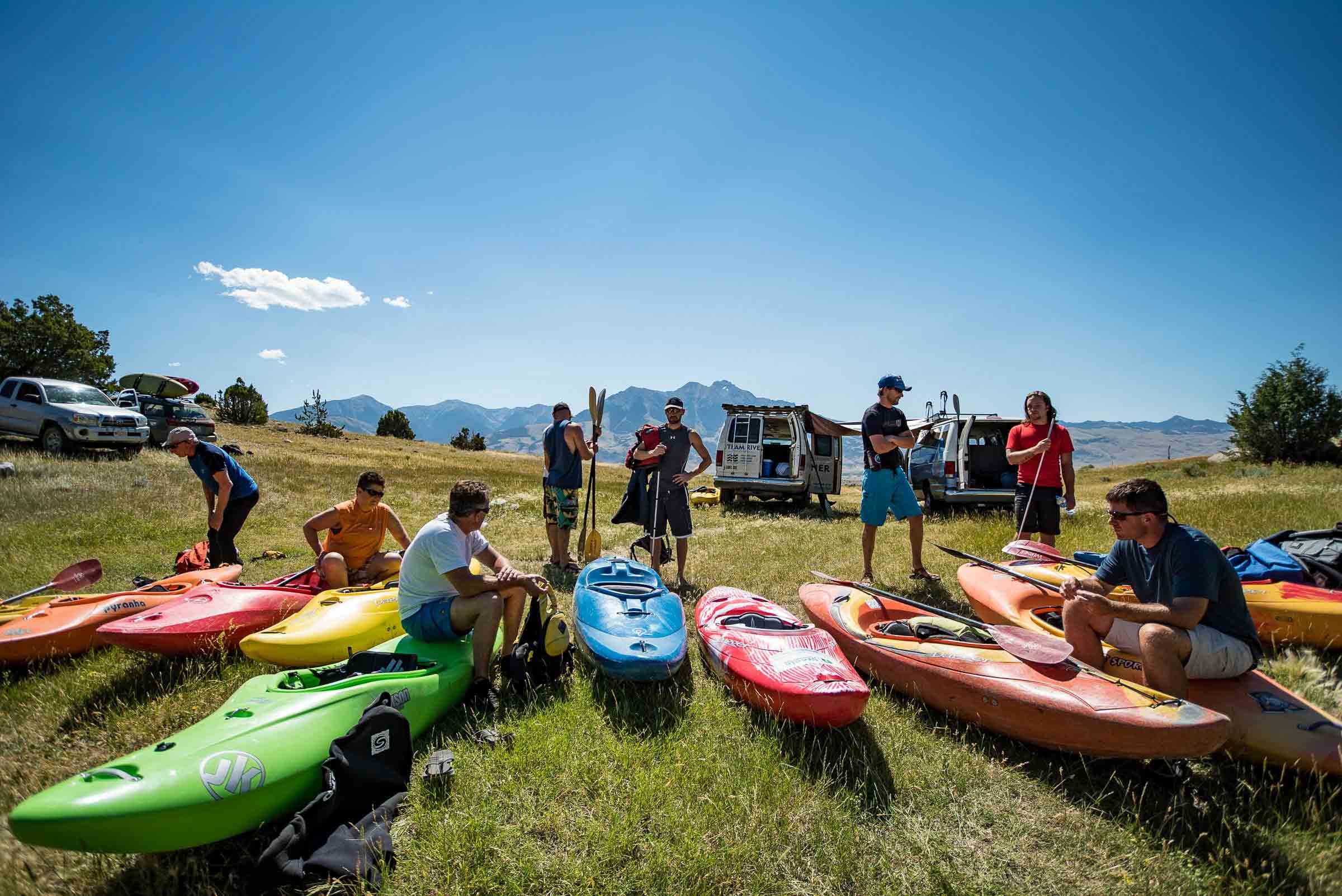

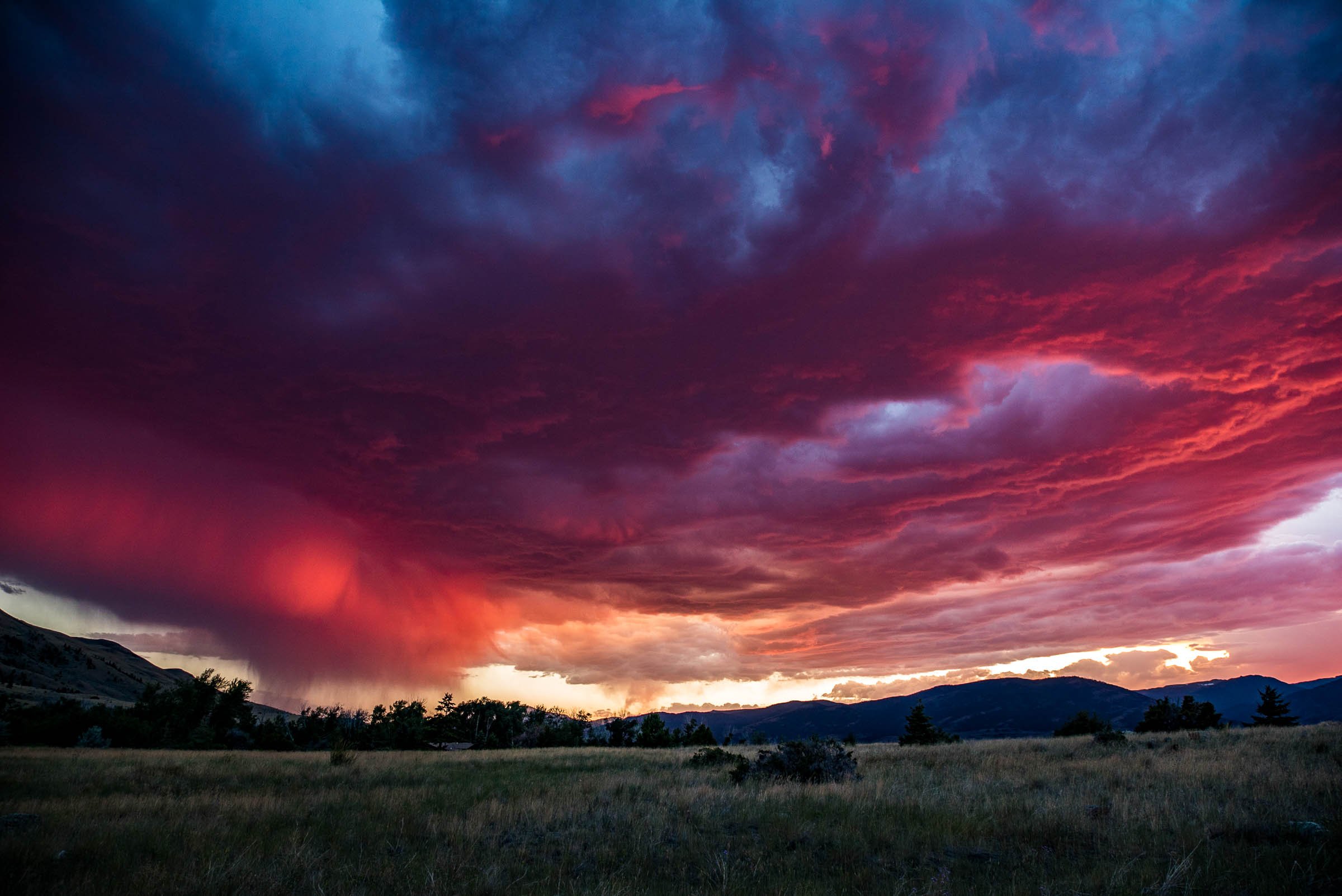
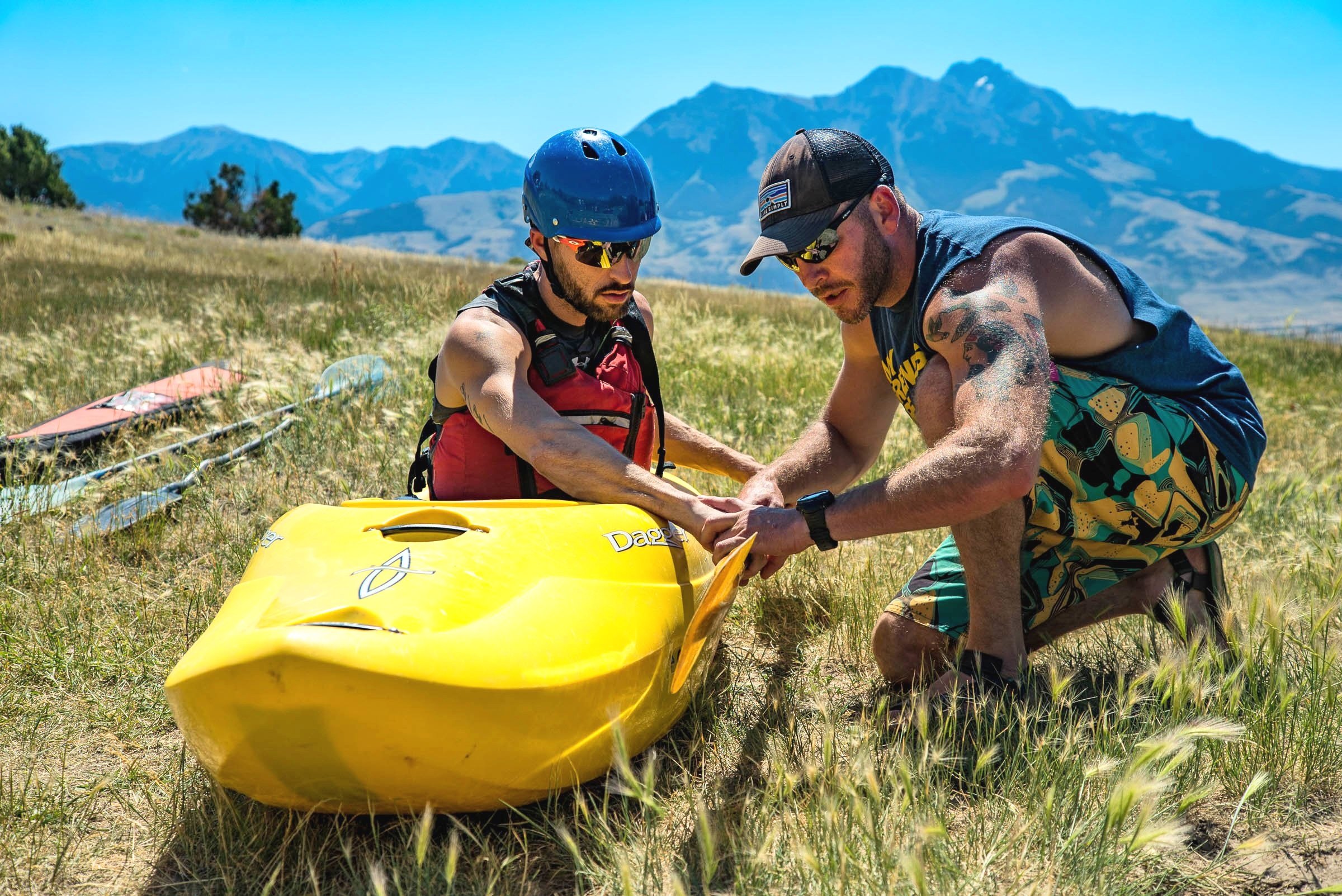
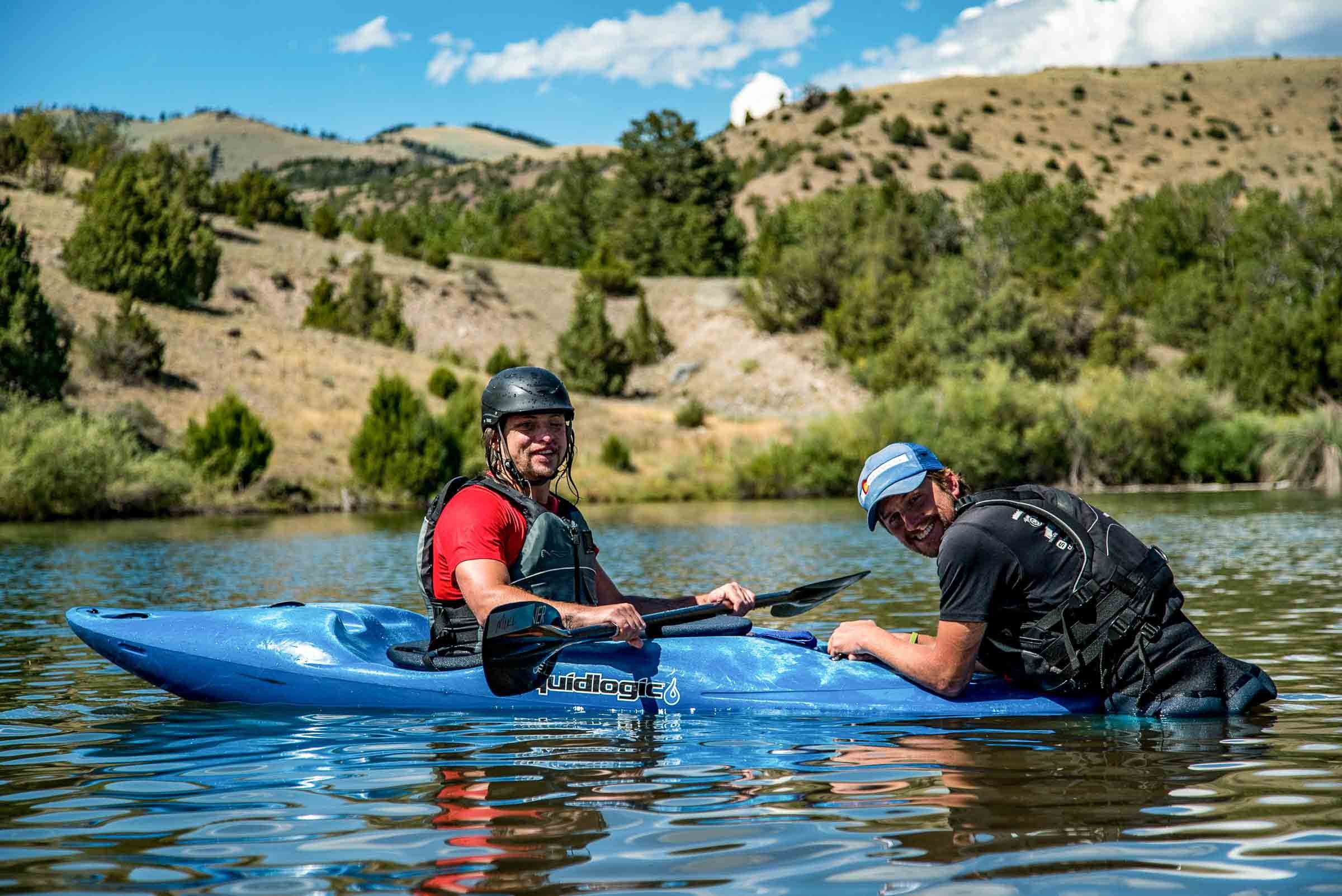
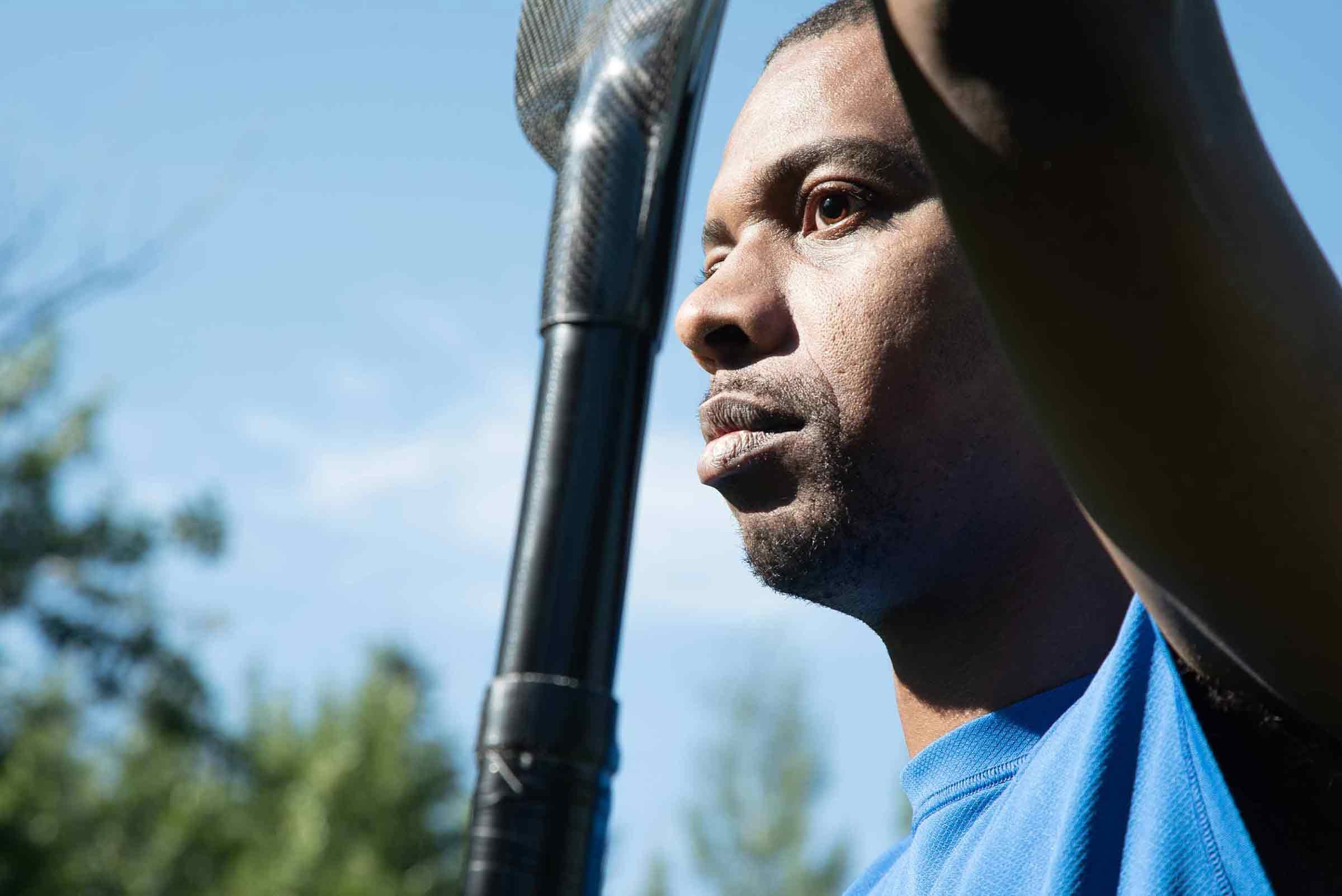

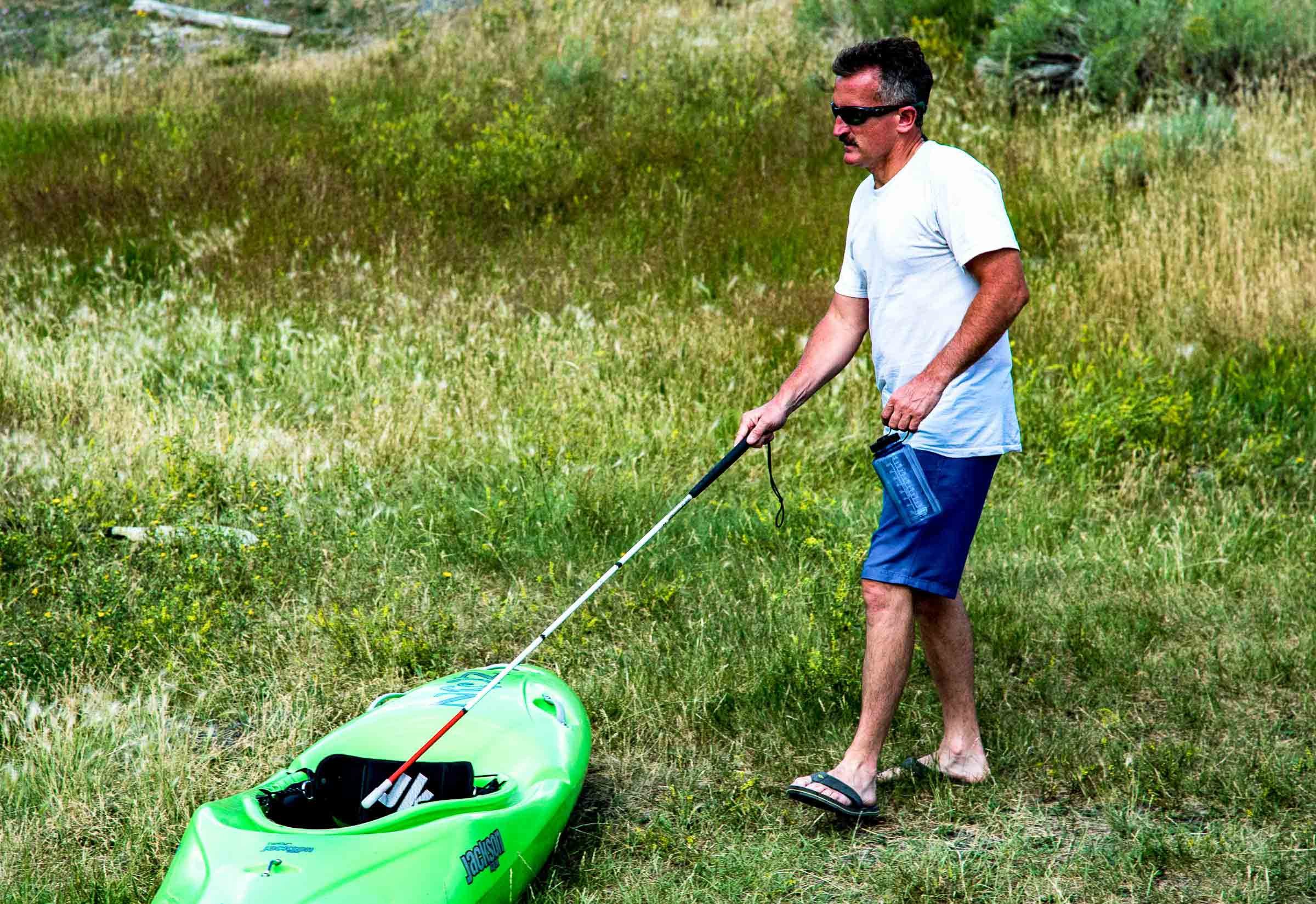
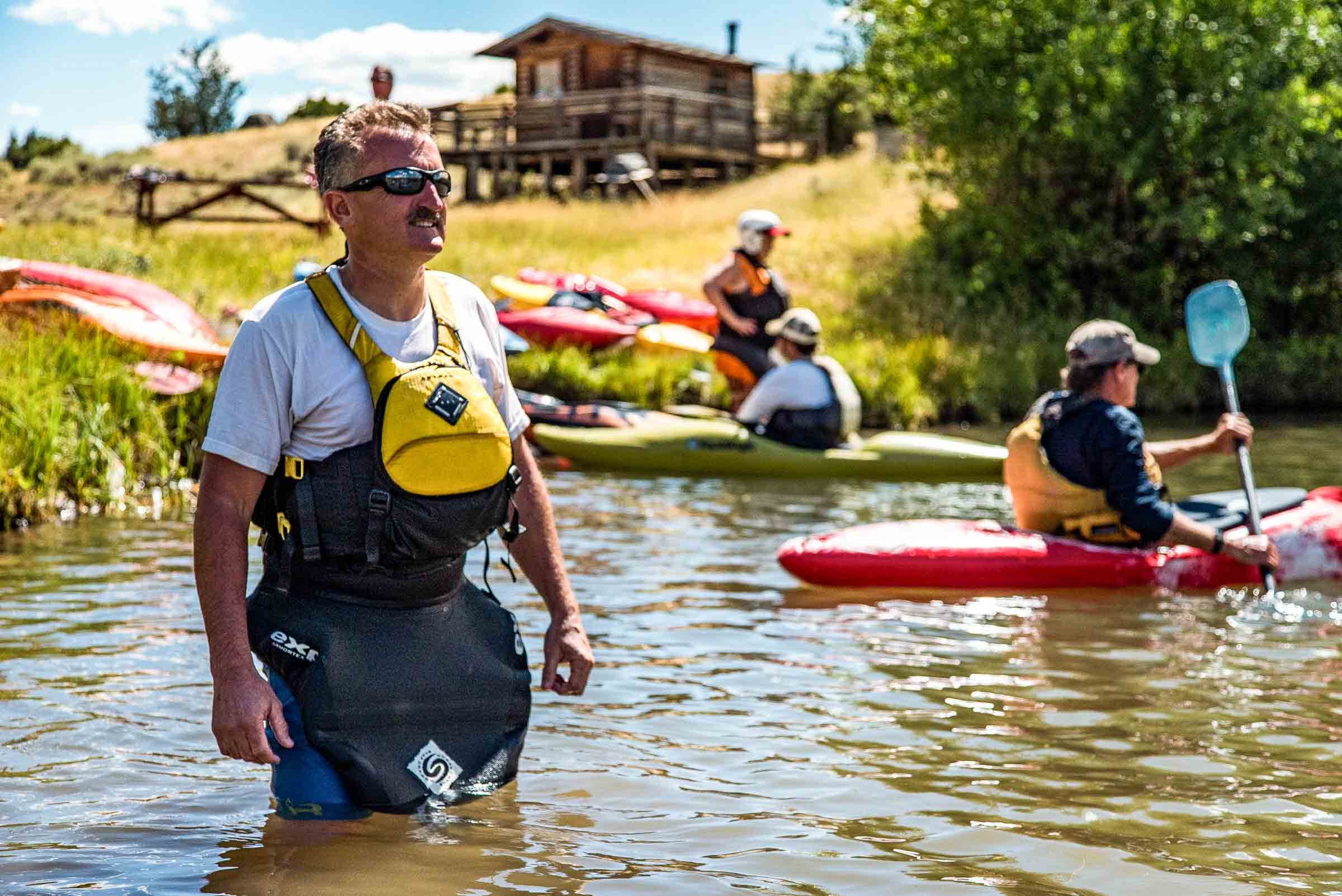
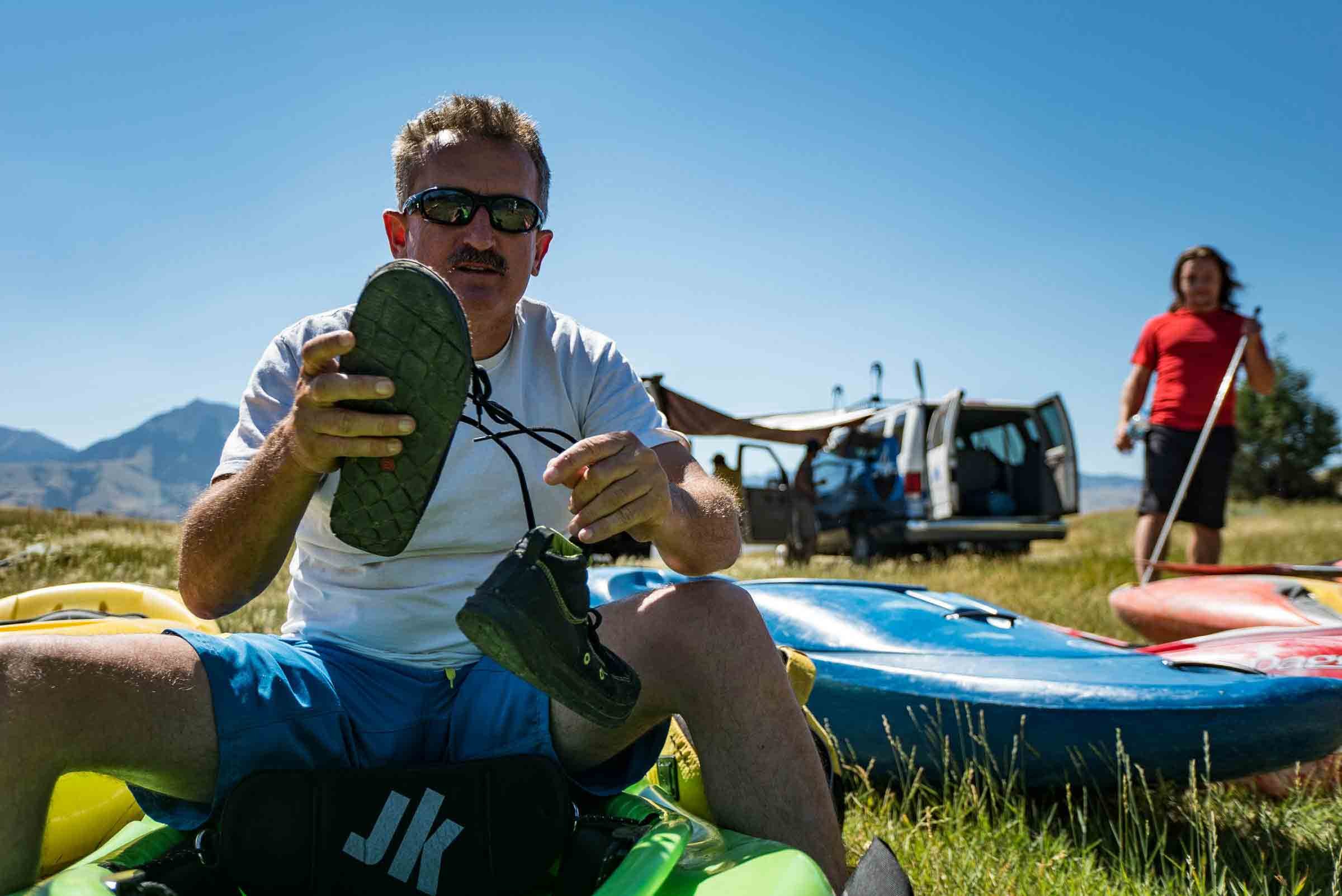
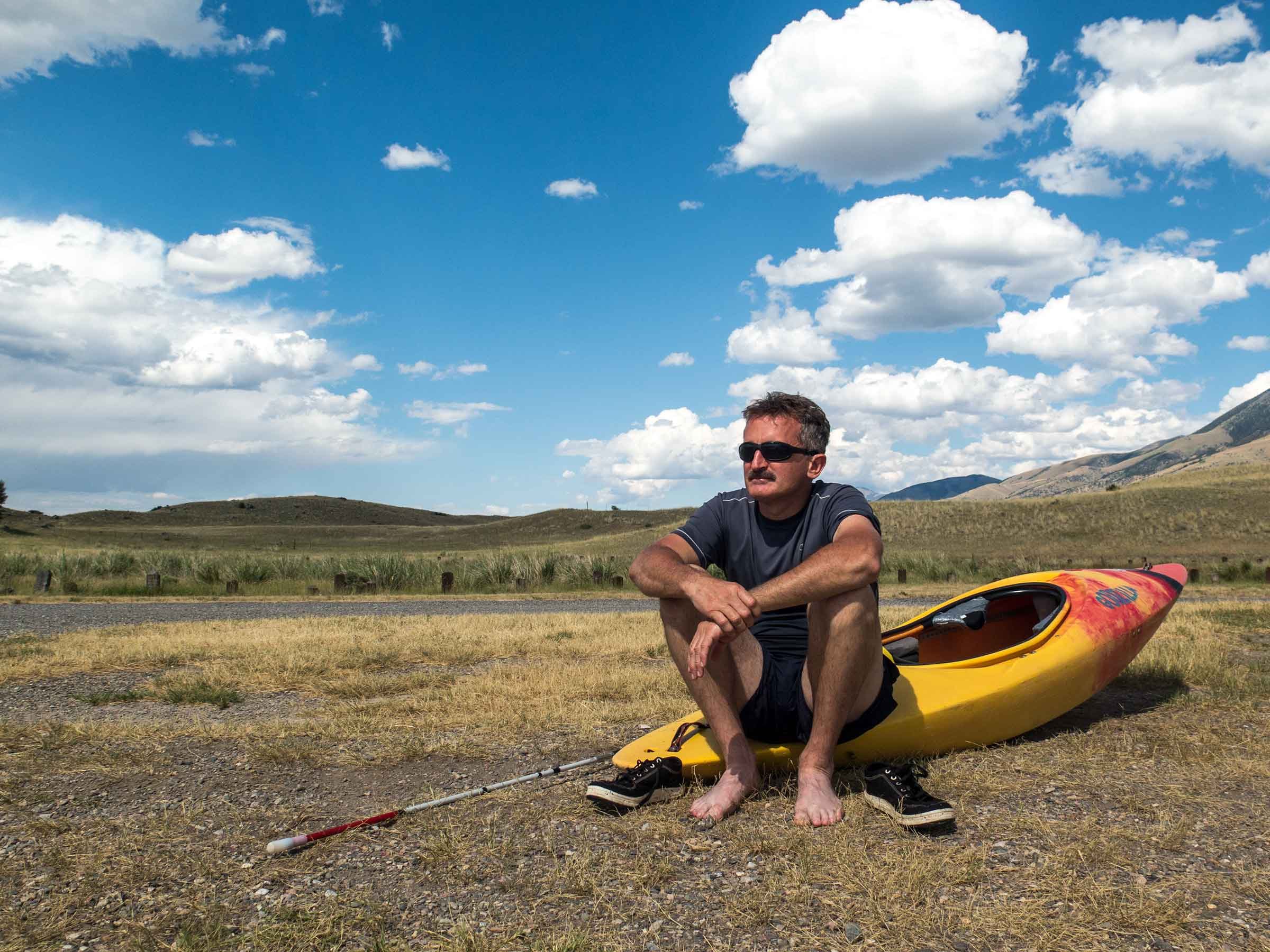
Bird Research
About seven miles east of downtown Boise, as the hawk flies, stands Lucky Peak and the Intermountain Bird Observatory’s (IBO) main research site. On a bare ridge sits a small shack and from late August through October the sky above is active with thousands of southbound raptors. From the hidden confines of the wooden blind, researchers sit undetected, patiently waiting to capture some of these magnificent birds of prey.
About seven miles east of downtown Boise, as the hawk flies, stands Lucky Peak and the Intermountain Bird Observatory’s (IBO) main research site. On a bare ridge sits a small shack and from late August through October the sky above is active with thousands of southbound raptors. From the hidden confines of the wooden blind, researchers sit undetected, patiently waiting to capture some of these magnificent birds of prey.
Having called ahead, my friend, Terri Gibbs and I were excited to see them up close. As we approached the structure, we were suddenly stopped by a man’s voice coming from a dark slab of window, cut from the plywood. I quickly looked around, hoping I hadn’t thwarted a potential capture.
“That’s Jay,” Terri said.
Off to my right and on the ground a subtle movement caught my eye. A pigeon stood covered in leather body armor, situated carefully as bait, behind a tall net barrier.
Thirty seconds later Jay waved us forward and we entered the blind.
We were met by volunteer Robin Leonard and IBO Research Biologist Rob Miller. Next to Rob sat Research Director Jay Carlisle who has a Ph. D. in Biology studying songbird migration. For twenty years Jay has been a part of IBO, a non-profit research branch of the Department of Biological Sciences at Boise State University. During the fall migration Jay traps raptors a couple times a week. “It’s one of my favorite places on earth because of the birds,” Jay says about Lucky Peak. “I don’t have to go to the birds, they’re coming to me.” Through the large north facing window, behind him, loomed Boise Peak.
Every fall, since the start of the IBO in 1993, around 5,000-9,000 raptors of eighteen different species are counted around the Boise Foothills. They follow leading lines, along the Boise Ridge, traveling on wind currents towards the southernmost point at Lucky Peak. And they’re not alone. Owls and songbirds also congregate here, gathering fuel or resting before flying into the large expanse of the Snake River Plain. Lucky Peak is unique in that it offers “around the clock” research for many different bird species throughout the fall.
“If you can catch three or four birds in an hour than you’re doing pretty good.” Jay says about trapping raptors. “It comes in waves.” Rob and Jay patiently scanned the sky.
Suddenly, a Cooper’s Hawk swooped down from its lofty height, lured by false hope of a free meal. They sprang to action and pulled strings attached to the lure bird’s body armor creating movement. The hawk landed and approached the bait, unaware of the bownet trap cocked and ready for action. At just the right second, Jay triggered the trap with impeccable timing. The spring loaded net quickly covered the hawk and Jay ran out to retrieve the captured bird.
The Cooper’s Hawk looked straight ahead with intense eyes, wings fanned out and beak open, boldly posed. Robin attached an identification band to the bird’s leg, took measurements and gathered other important data. Researchers here capture and band roughly 1,000 raptors each fall. On average, about nine of these birds will be recovered at other sites across North America, giving important information on raptor movement, wintering grounds, and even mortalities.
Eventually we moved outside to release the birds. Terri and I gathered around Rob as he educated us on Cooper’s Hawks and I soon realized the IBO is much more than a place that simply captures and bands pretty birds. It’s also a place that helps cultivate an inspiration for the natural world through education and awareness.
“By having a couple thousand visitors every year their eyes open to this highway of raptors migrating by.” Jay says, “I hope that maybe it helps to grow more of a conservation ethic.”
They held the birds out at arm's distance. The hawks quickly leaned forward with wings spread and powerfully lunged into flight. It was fun to think that they could fly to California or, better yet, Mexico for winter. Soon they disappeared into the large expanse of sky above the Treasure Valley.
I left impressed, not only by the fierce beauty of the hawks but also by the passions of the people that study them.
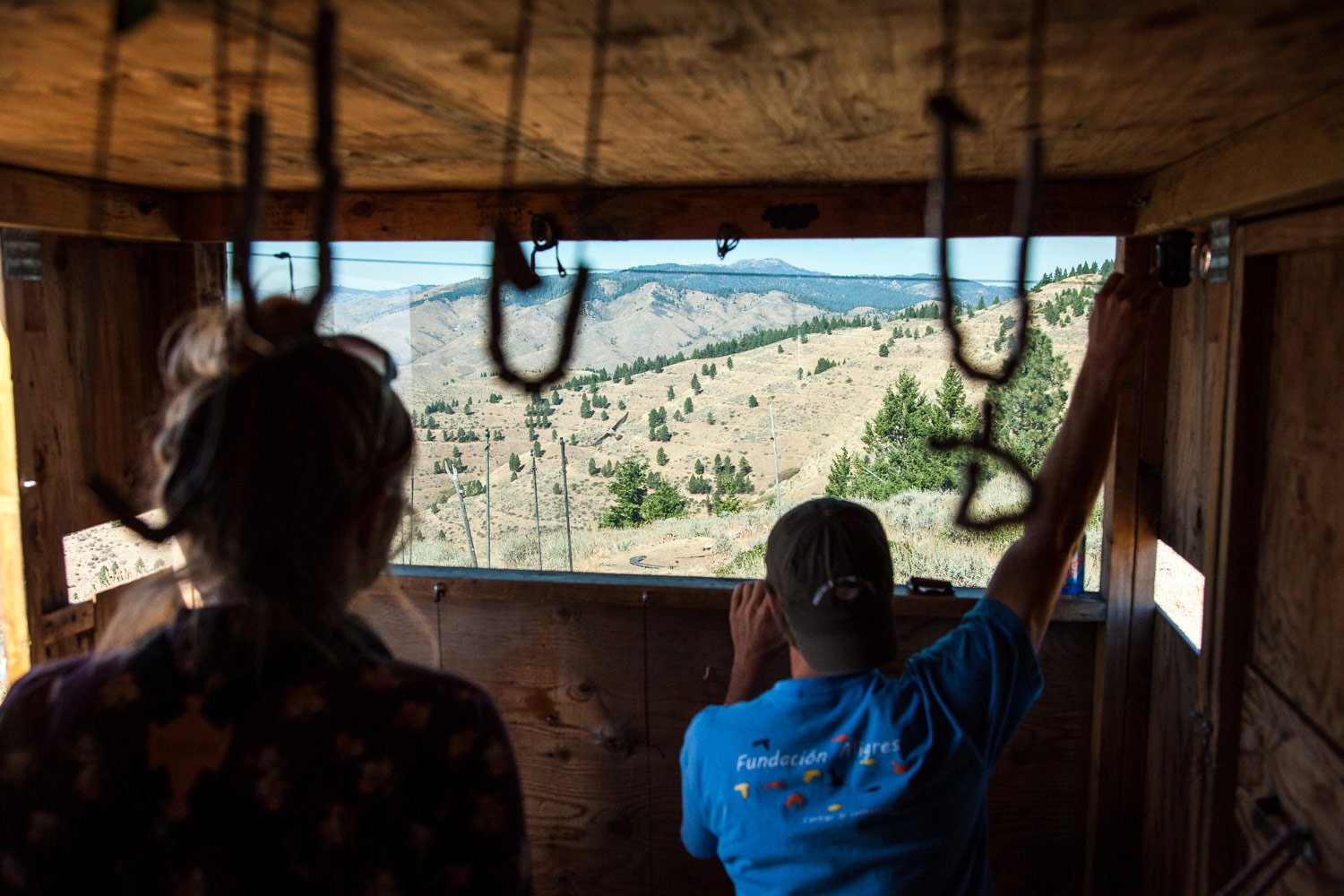
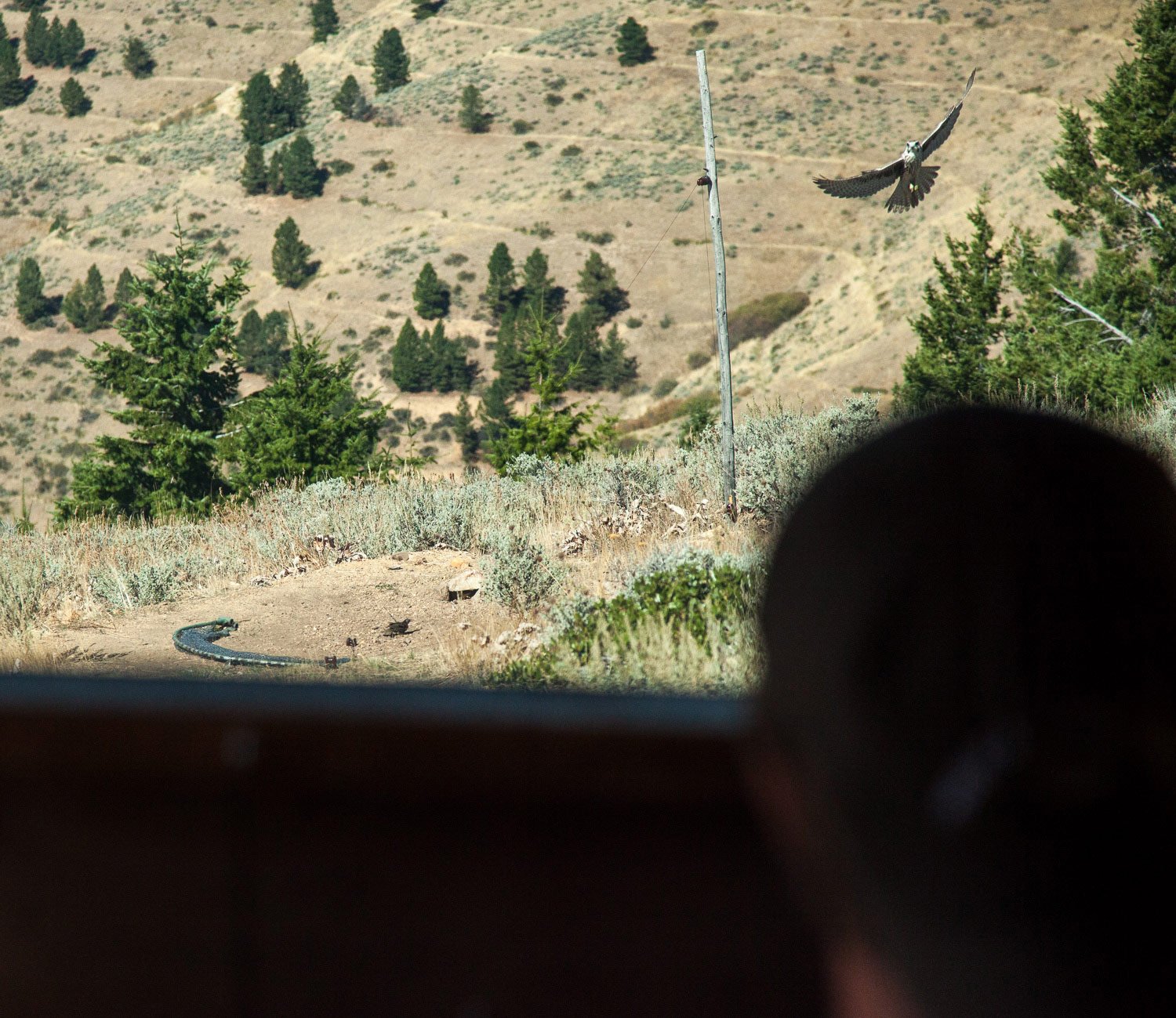
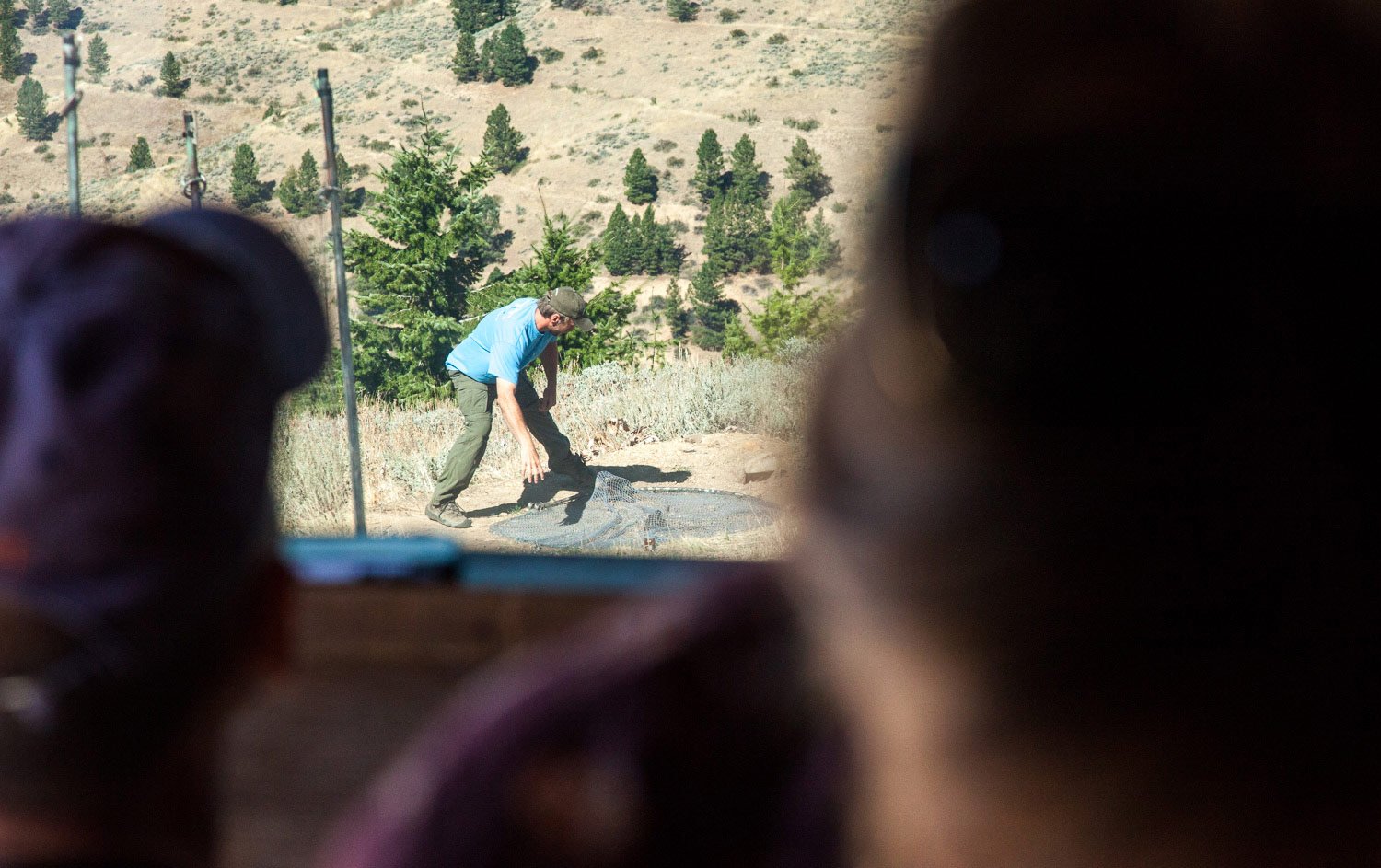




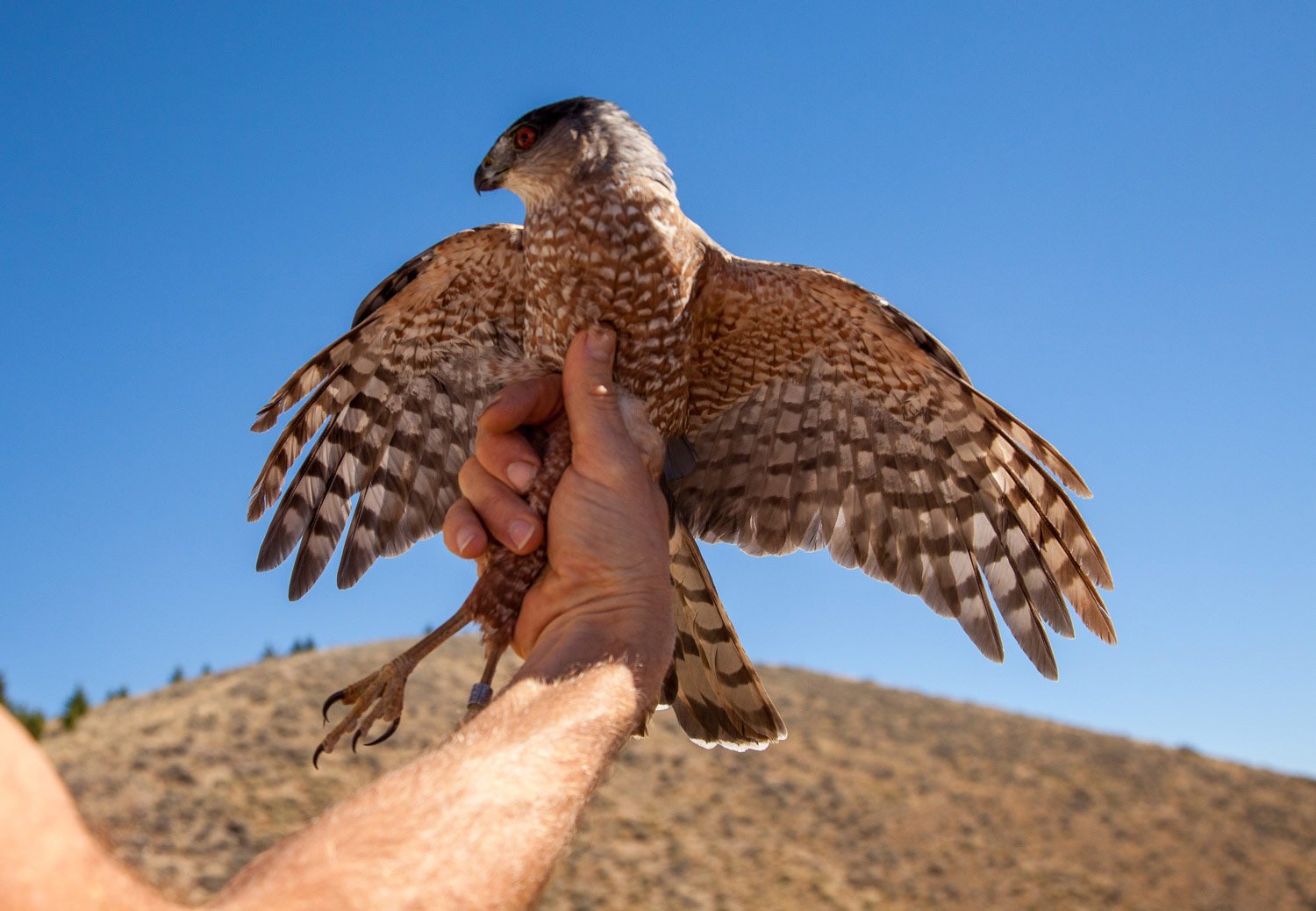

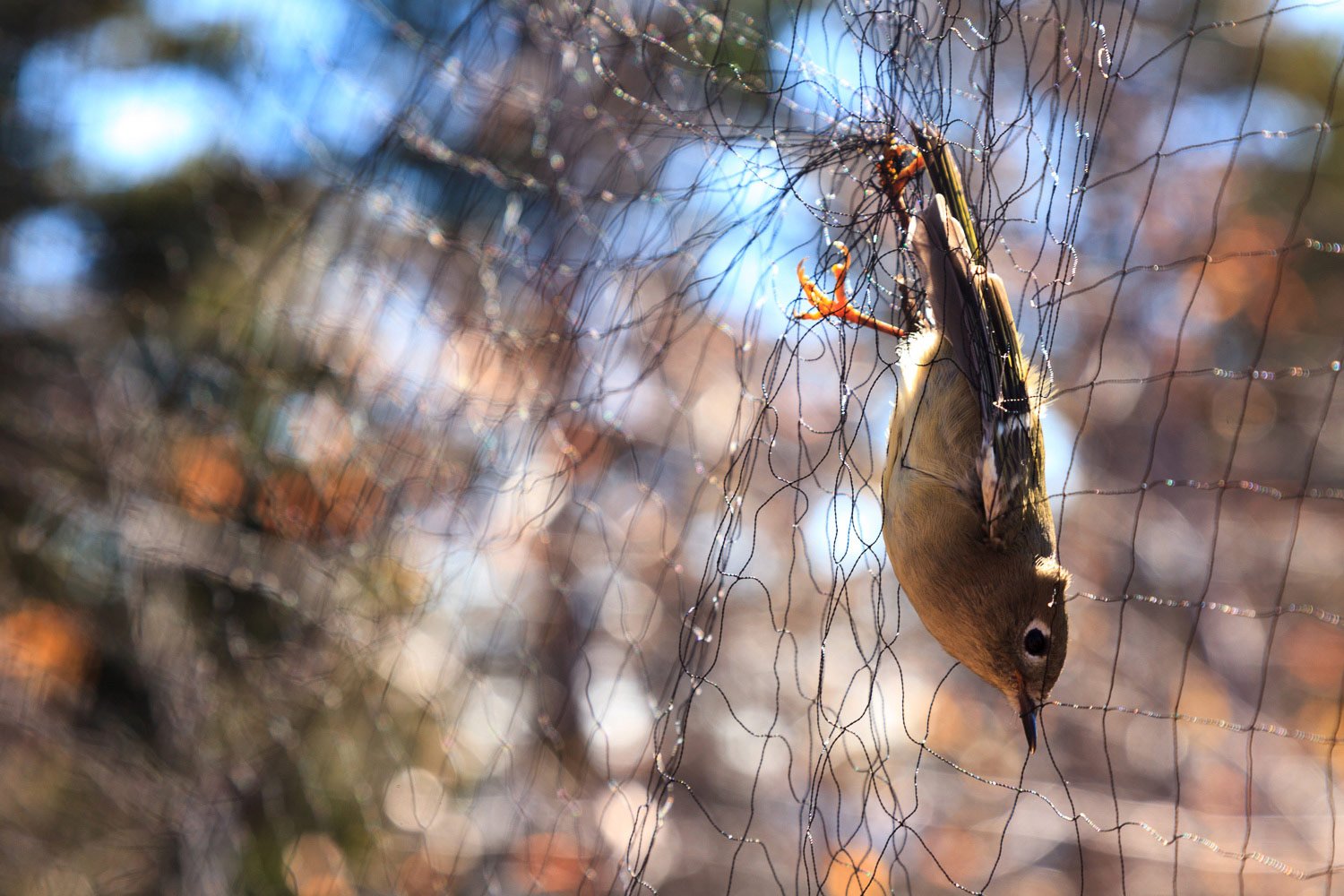
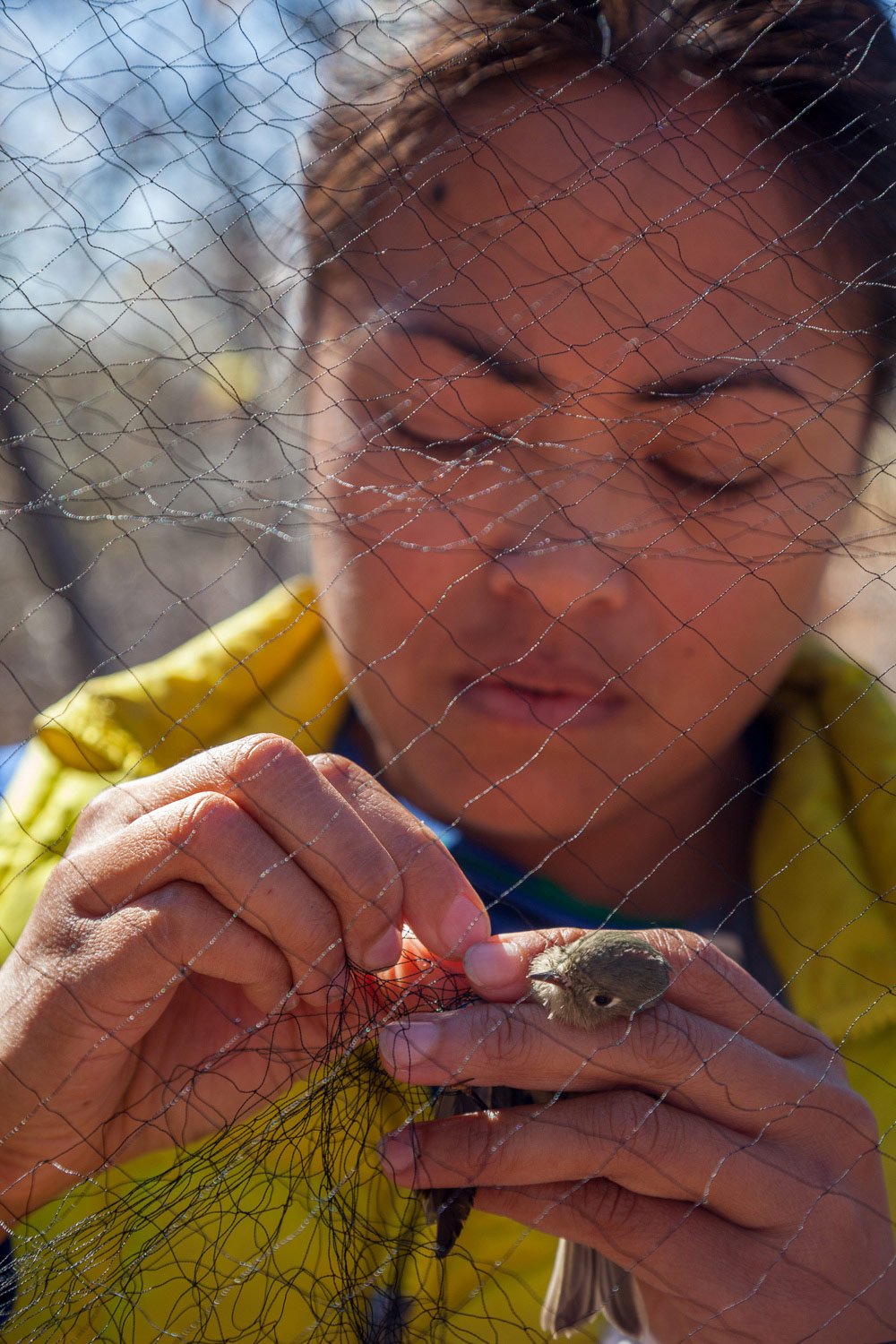
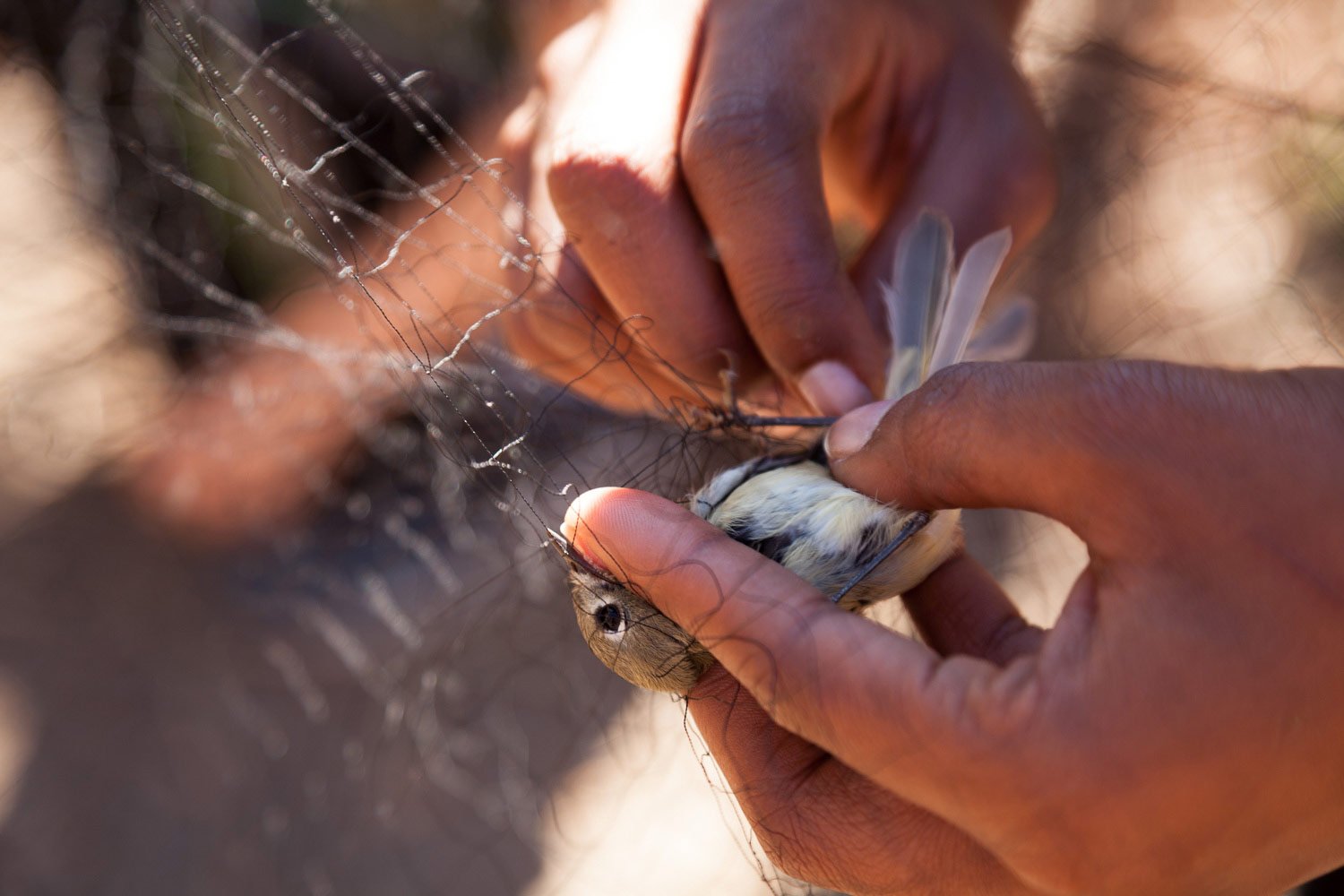
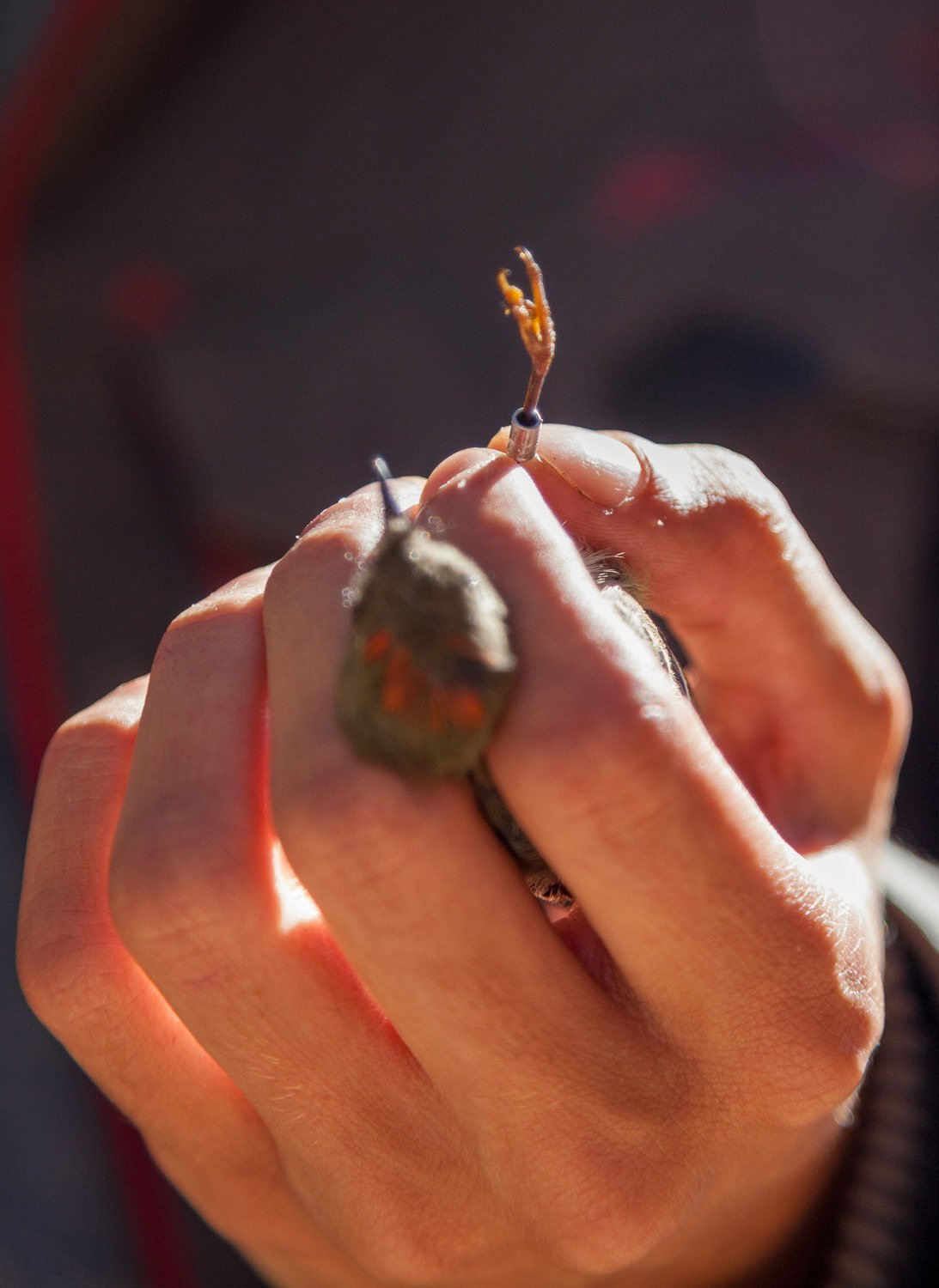
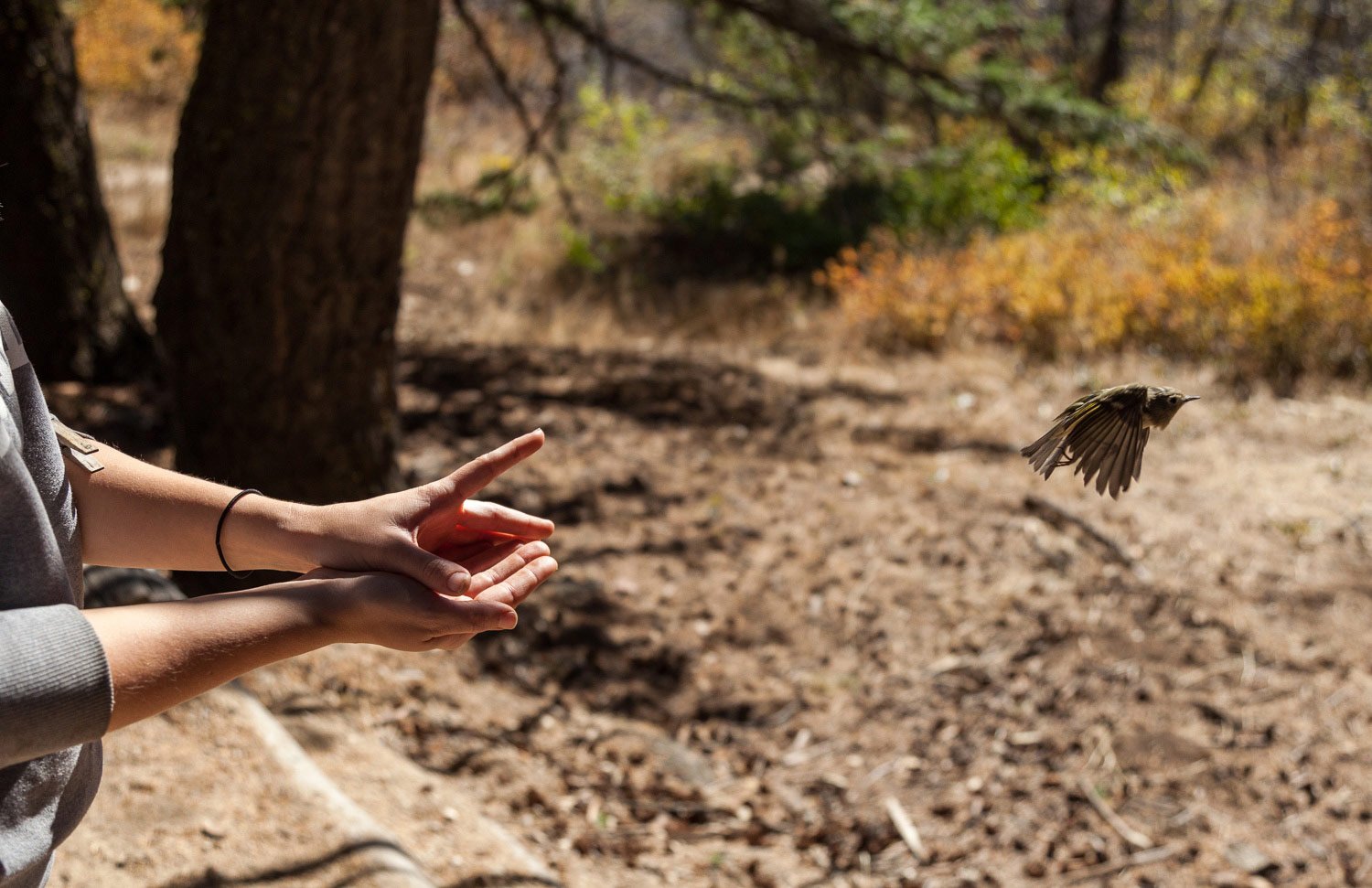
Working the Middle Fork of the Salmon River
During the grey and cold days of past winters, and yet again today, I find myself sitting in my apartment daydreaming about a place and a people I’ve grown to love. This deep admiration started ten years ago when I first experienced a six day river trip down Idaho’s Middle Fork of the Salmon River. I soon traveled from Montana seasonally to work this stunning stretch of water and for eight years now I have accumulated many fond memories.
During the grey and cold days of past winters, and yet again today, I find myself sitting in my apartment daydreaming about a place and a people I’ve grown to love. This deep admiration started ten years ago when I first experienced a six day river trip down Idaho’s Middle Fork of the Salmon River. I soon traveled from Montana seasonally to work this stunning stretch of water and for eight years now I have accumulated many fond memories.
The Middle Fork flows wild and free for 100 miles through the heart of the Frank Church-River of No Return Wilderness. It drops almost 3,000 feet during its trip, crashing through numerous rapids with names like “Pistol Creek” and “Devil’s Tooth.” Its scenery changes from high alpine forest to mountain desert and finishes with a bang as it cuts through a steep rocky gorge named the “Impassable Canyon.” It is a unique trip and a natural treasure.
I often think about those warm sweep boat days bathed in golden light. The sun drops low in the sky and the craft is pulled by a free current. The flying insects are illuminated amongst the tall grass and the pine and fir trees cast shadows across the river. The birds sing with the sounds of the river and water laps the floor of the sweep. Together their voices became harmony to my ears and in that moment I feel truly alive!
I think about the guides around me. They seem to complete this place with their smiling faces and wild-eyes. They are strong, genuine, and friendly. Their lives, in many ways, reflect the wild and scenic river they work. As the season turns to spring they emulate the Chinook salmon and make their way back to the river, year after year.
These men and women come from many backgrounds and range in age and experience. They are the river’s ambassadors sharing its history and stories. Some are artists and musicians and others study the plants and animals of the area. These people are backcountry medics and Dutch oven masters. As river guides they are skilled boatman and they are a crafty and resilient bunch. They are Idahoan.
I think about the coming river season. Soon we will move downriver and gather around a campfire. There will be stories and good food. That night I will sleep under the stars and be filled with gratitude, forever thankful, for a community and a wild river that has carved its course through my life.
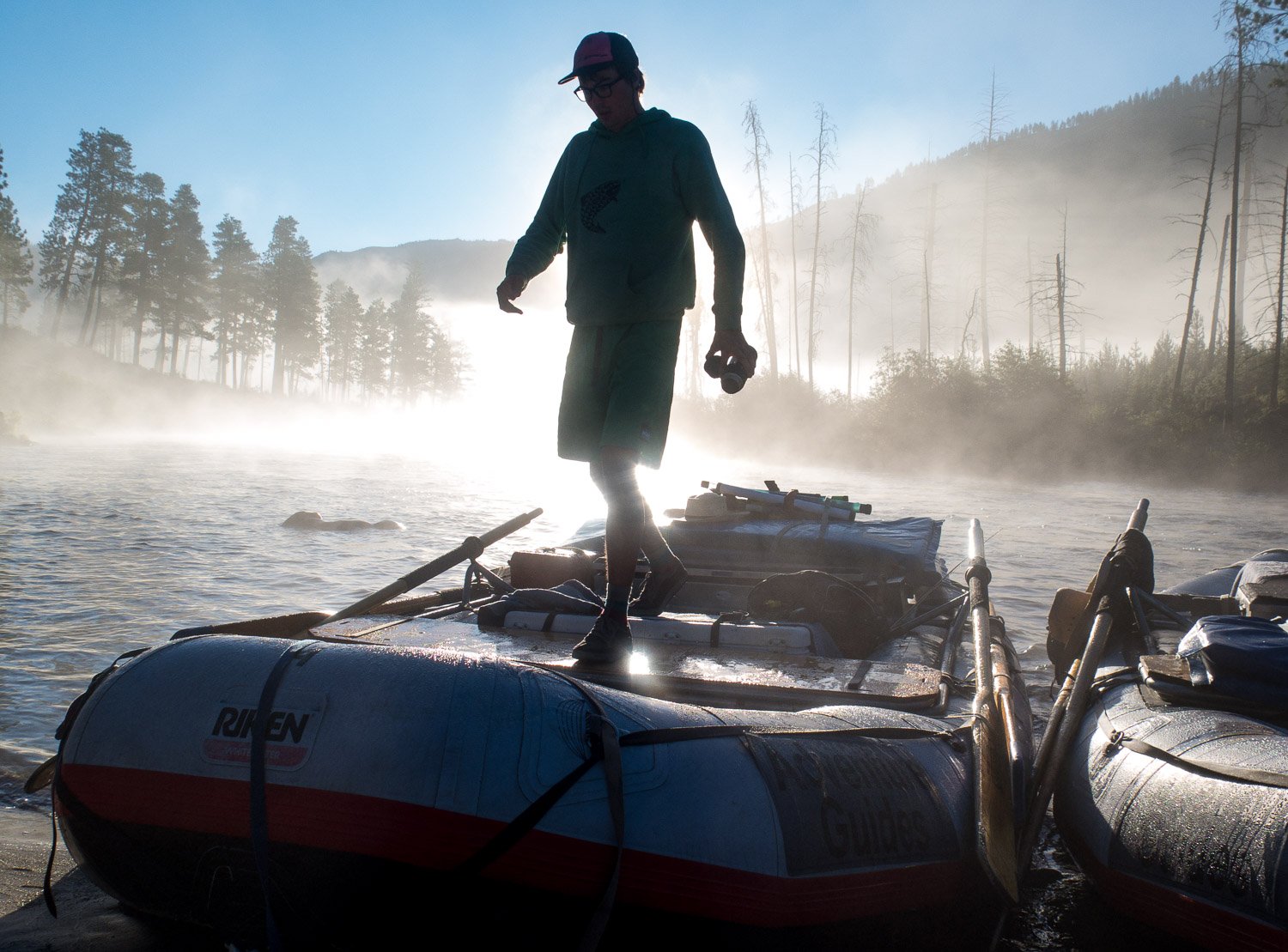
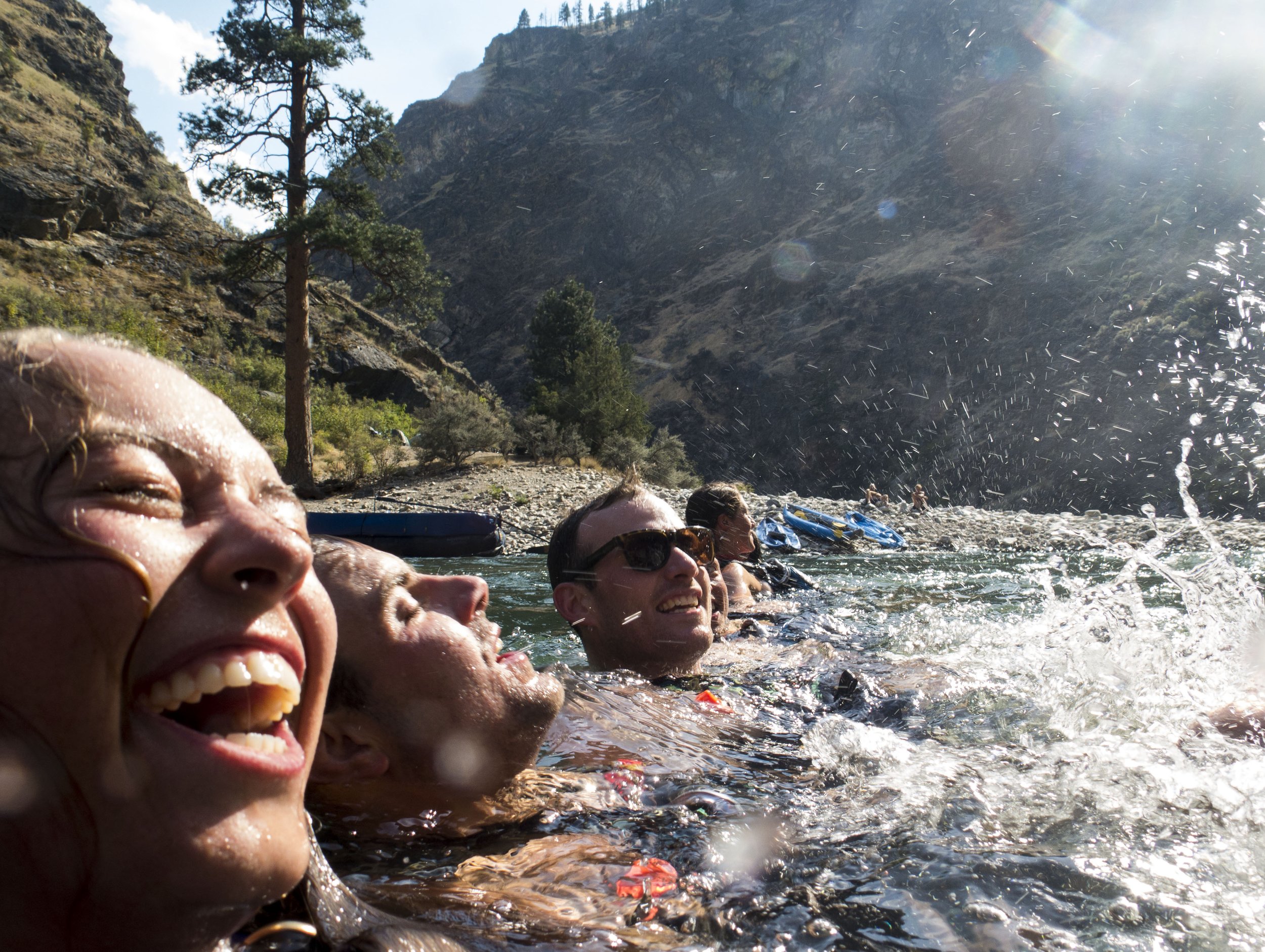
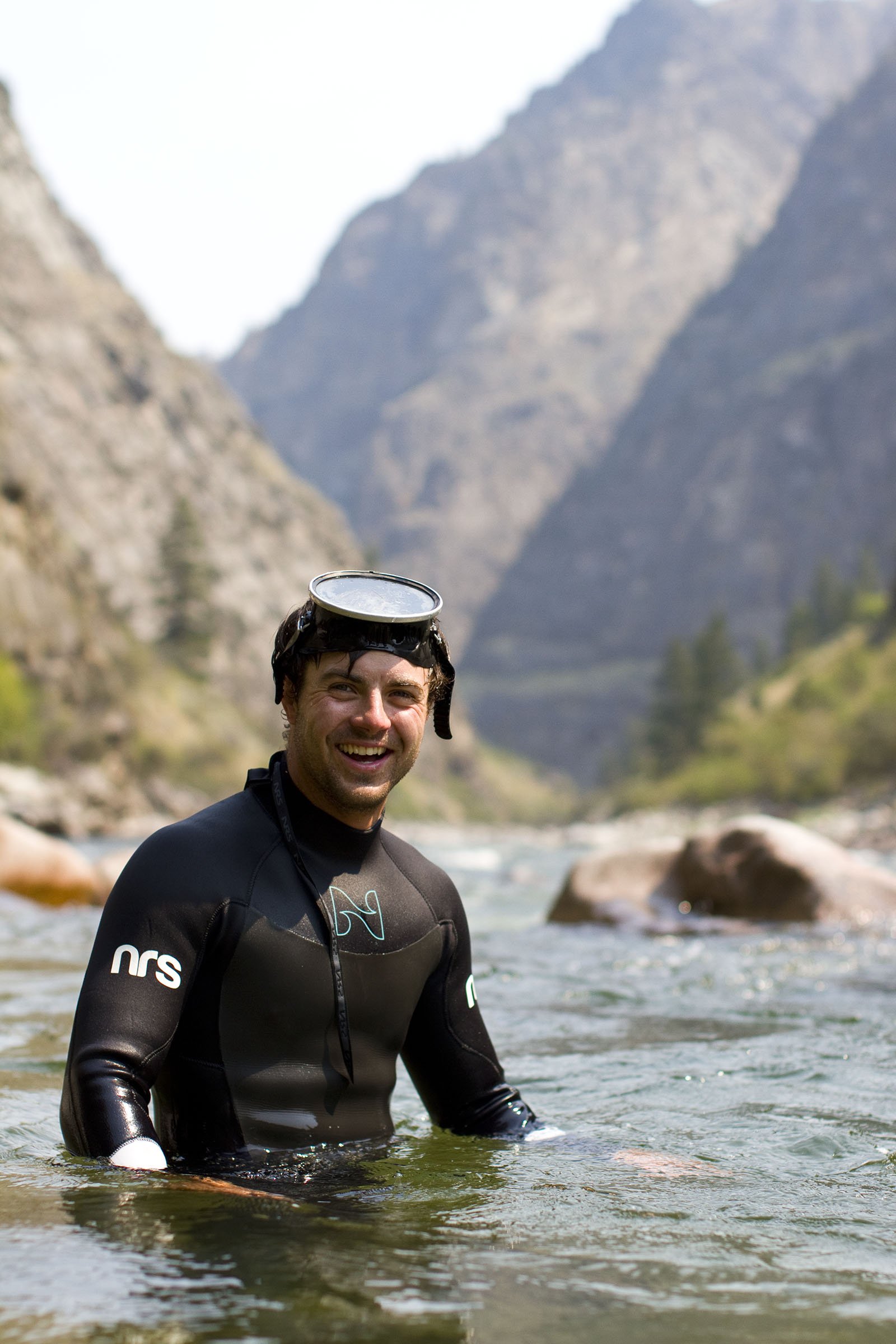
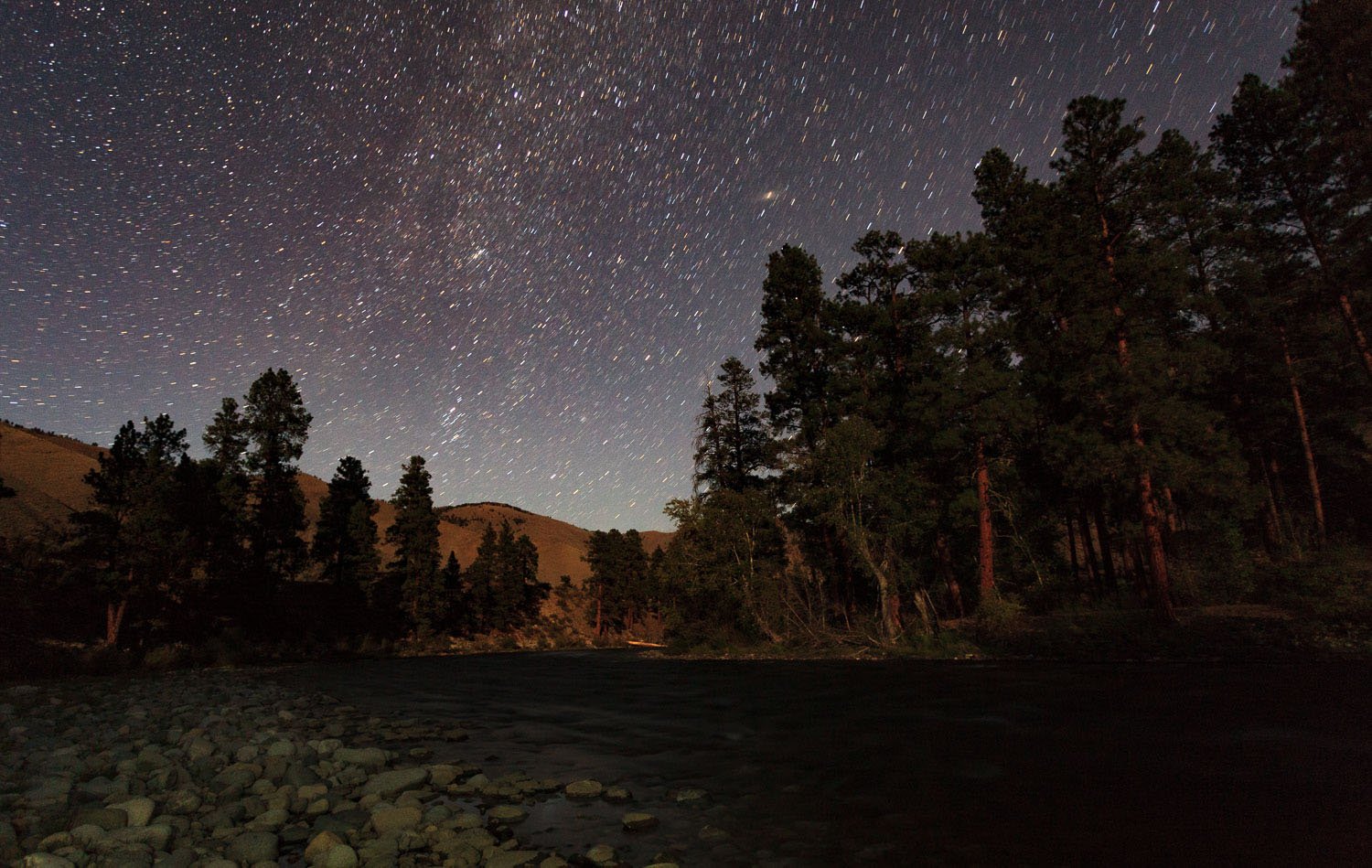
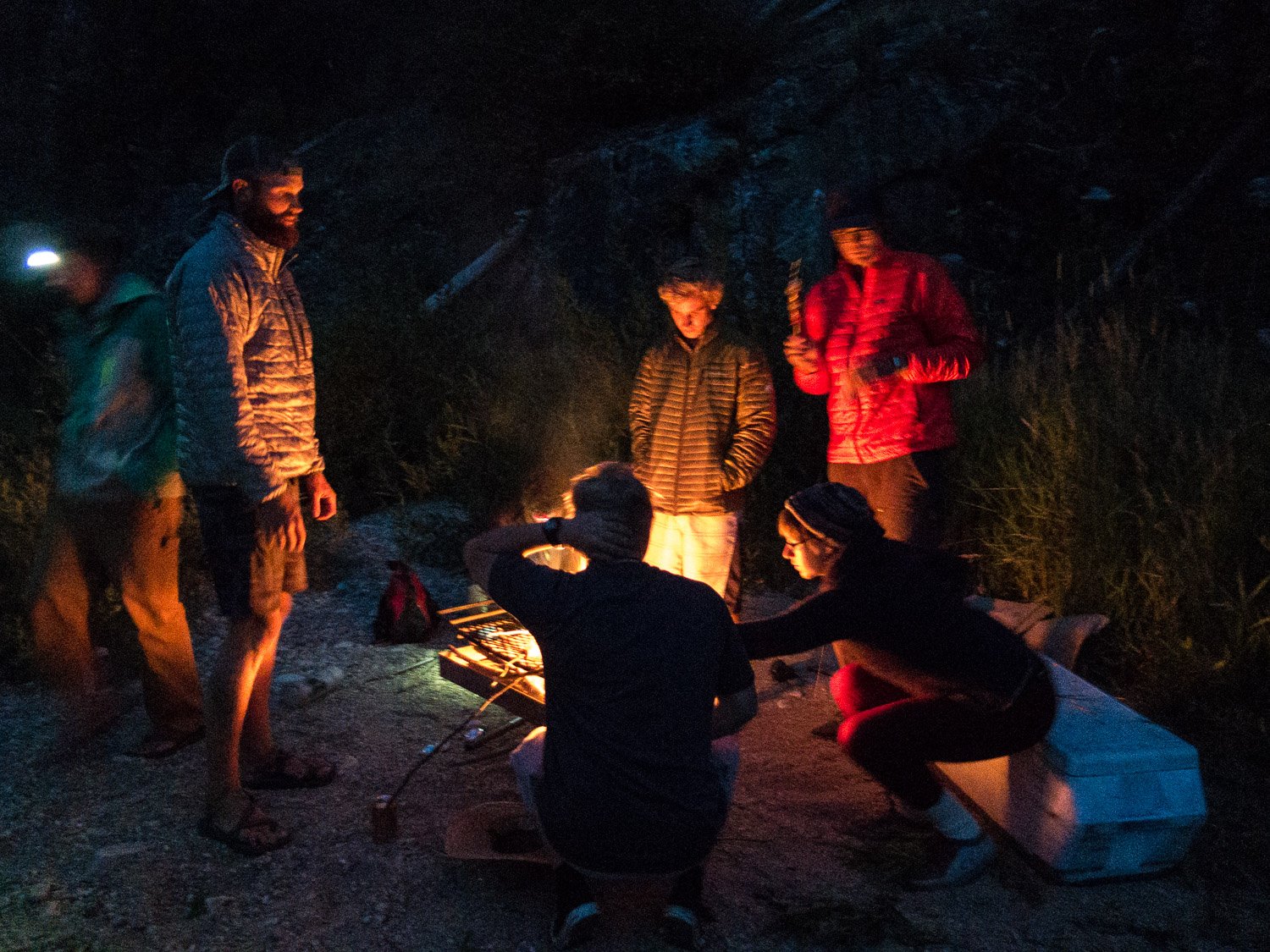
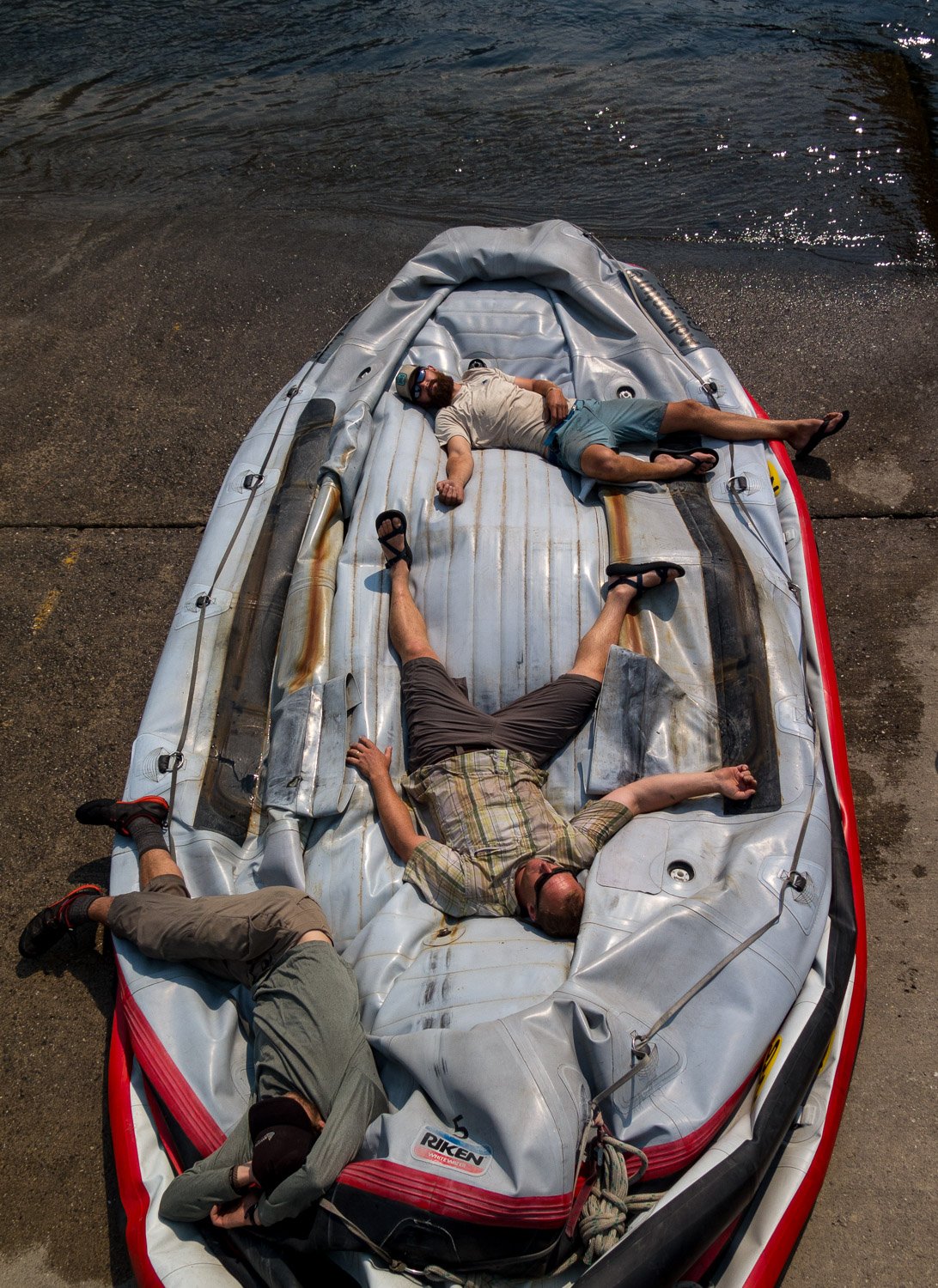
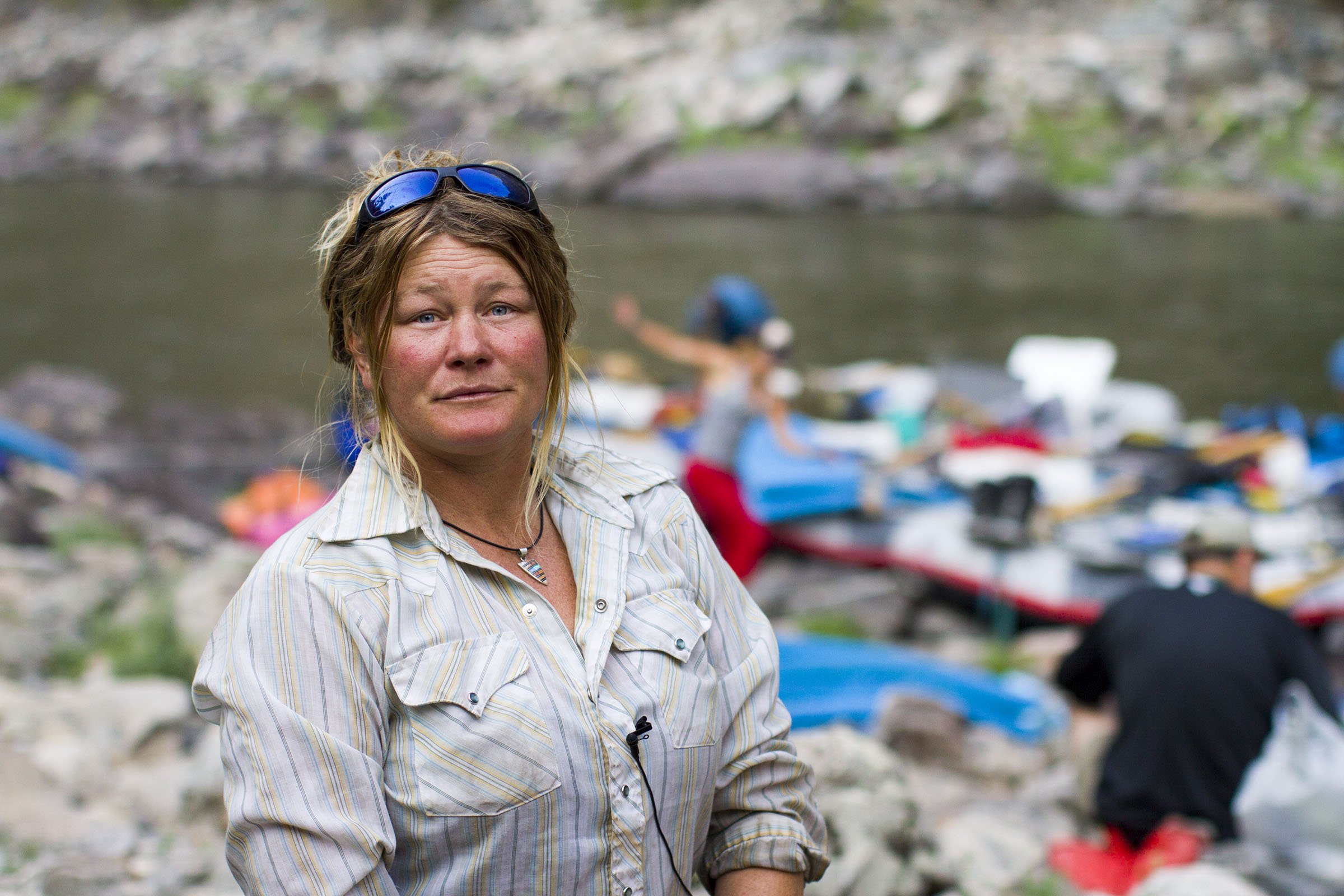
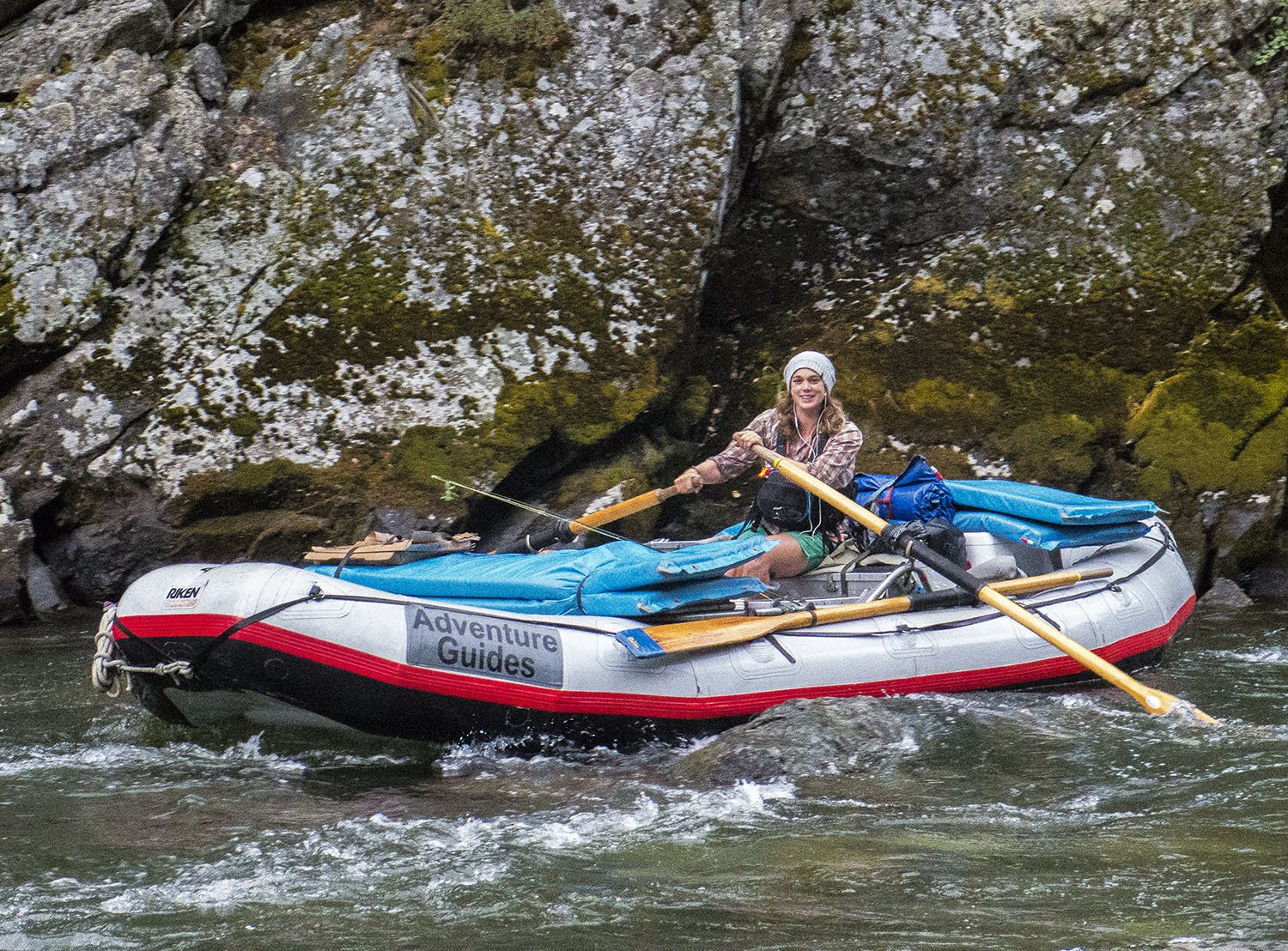
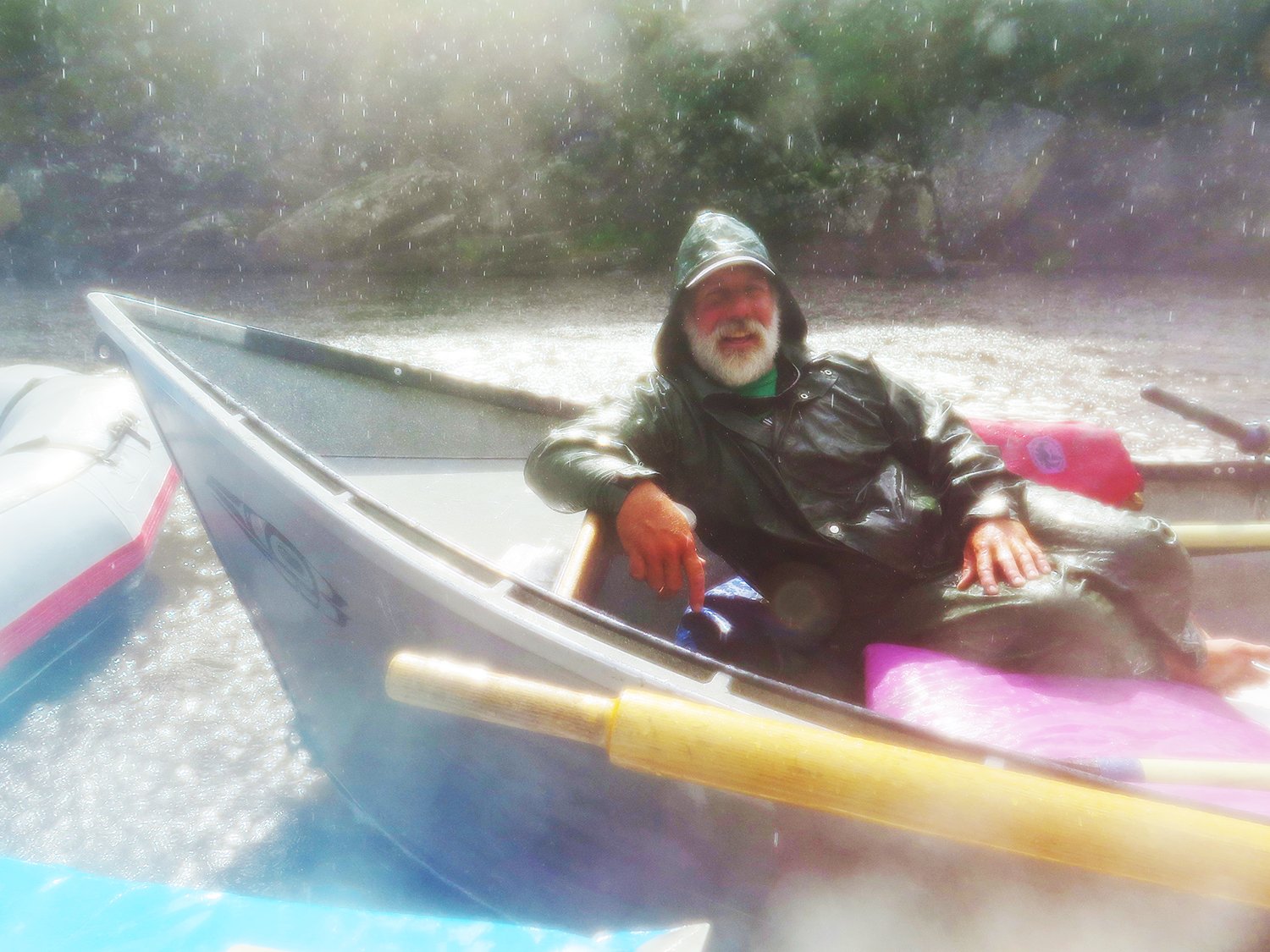
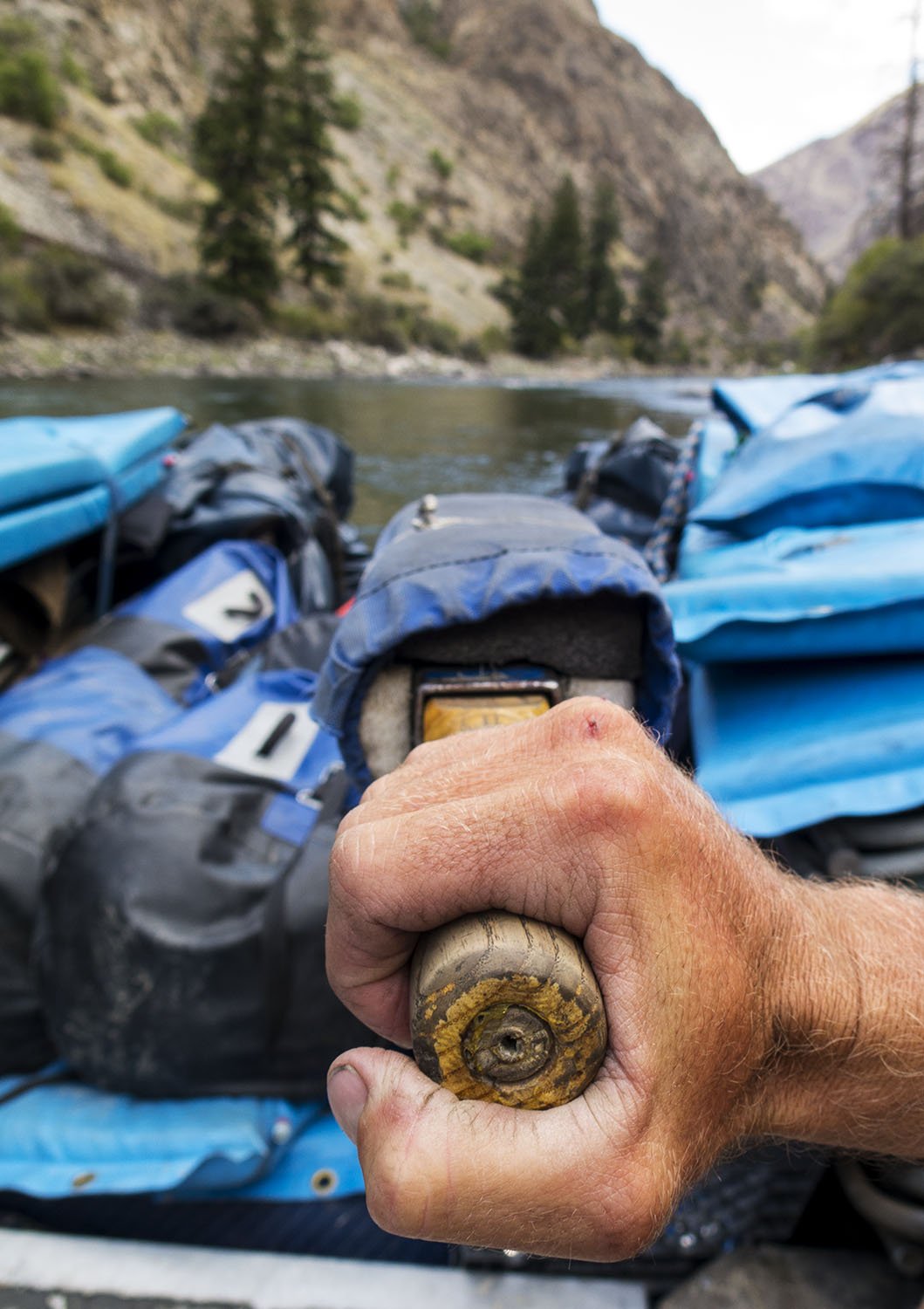
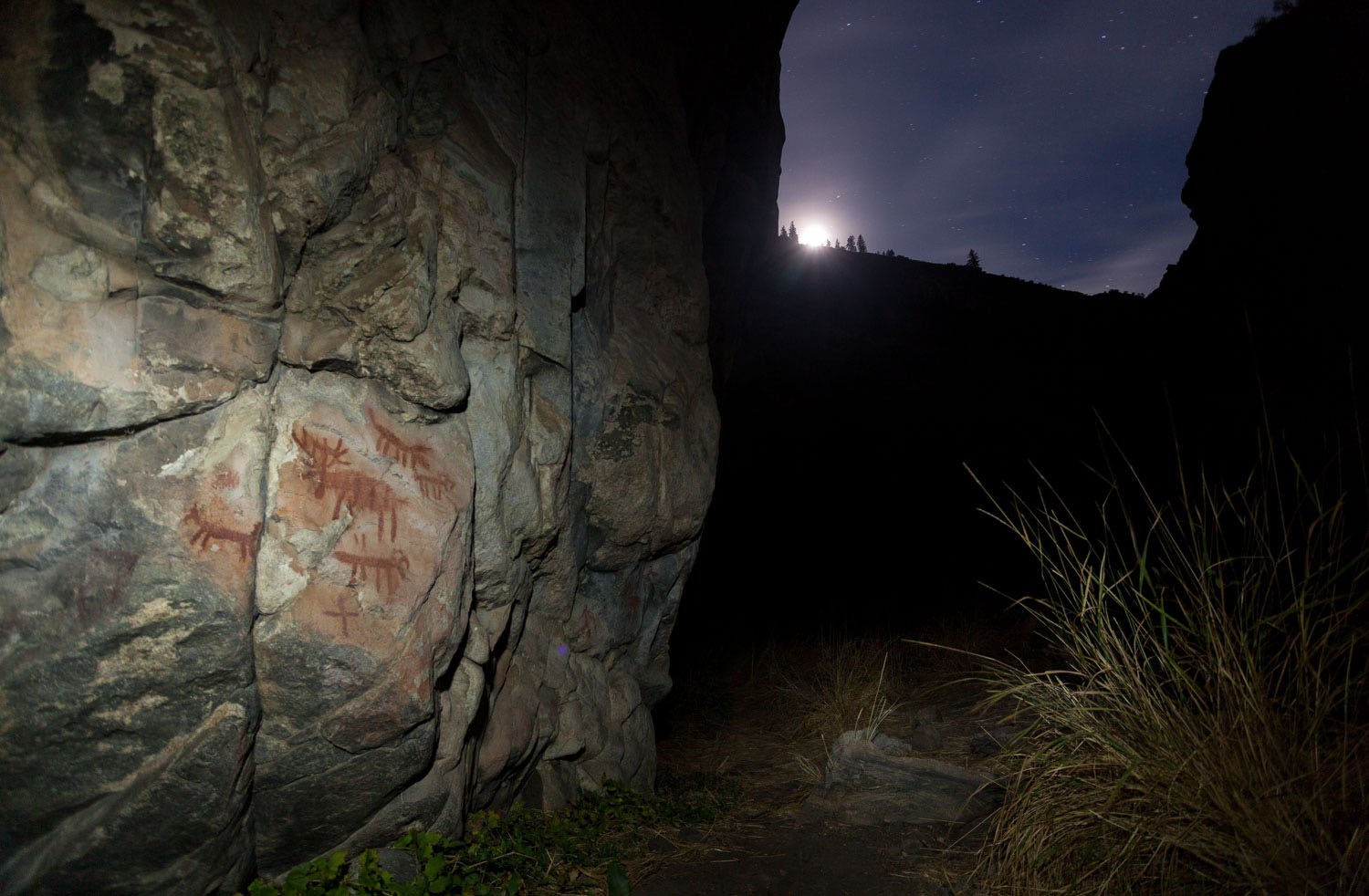
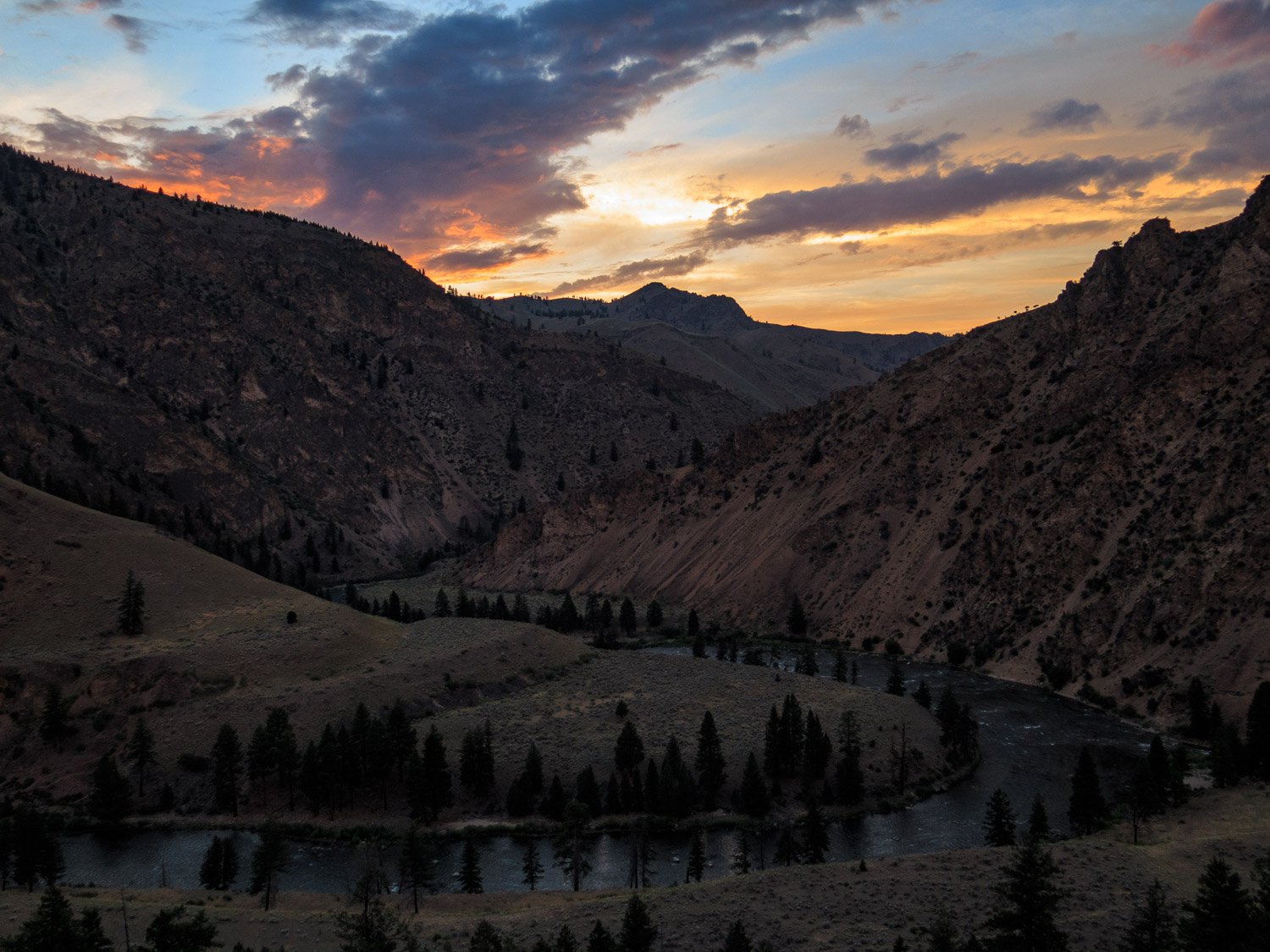
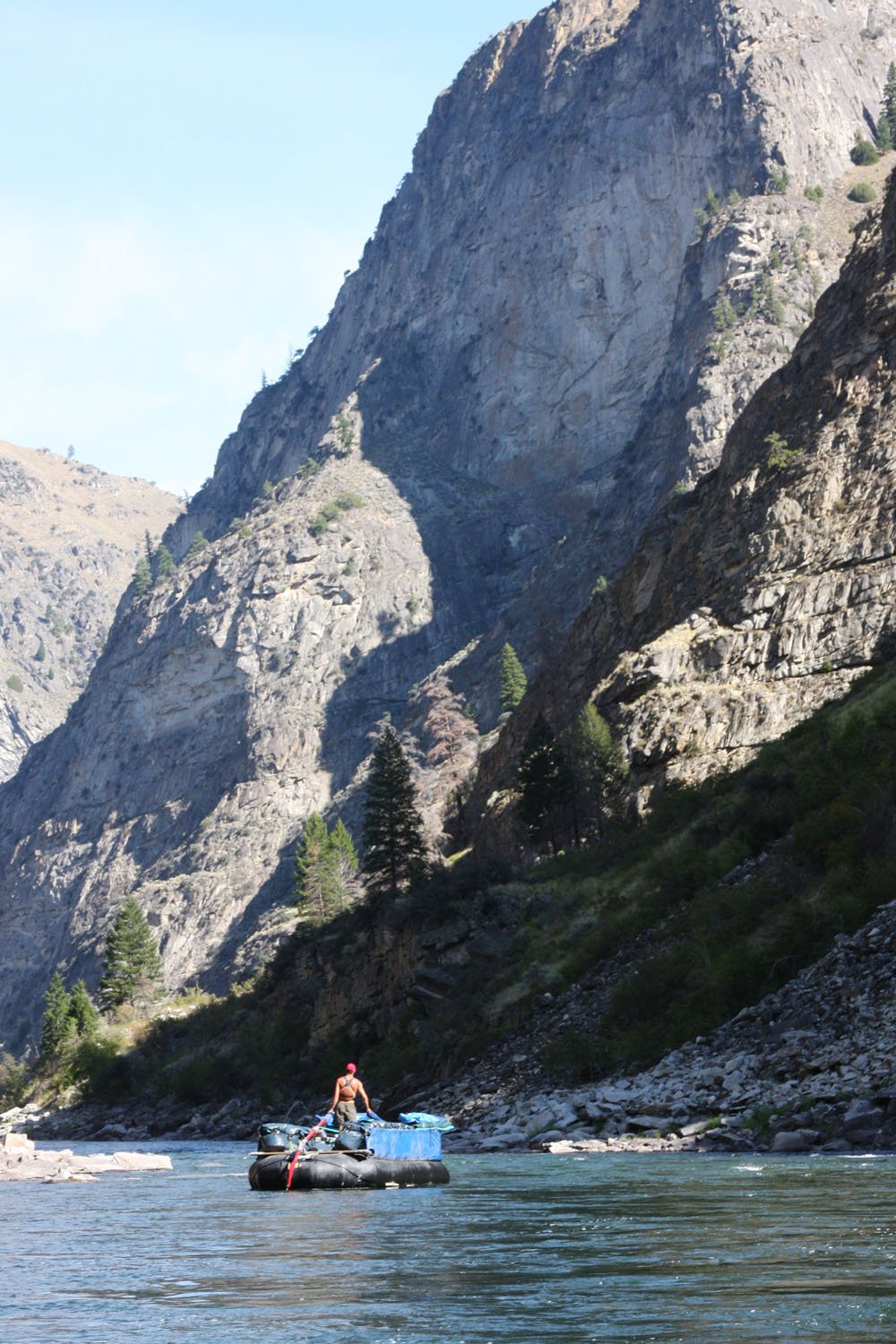
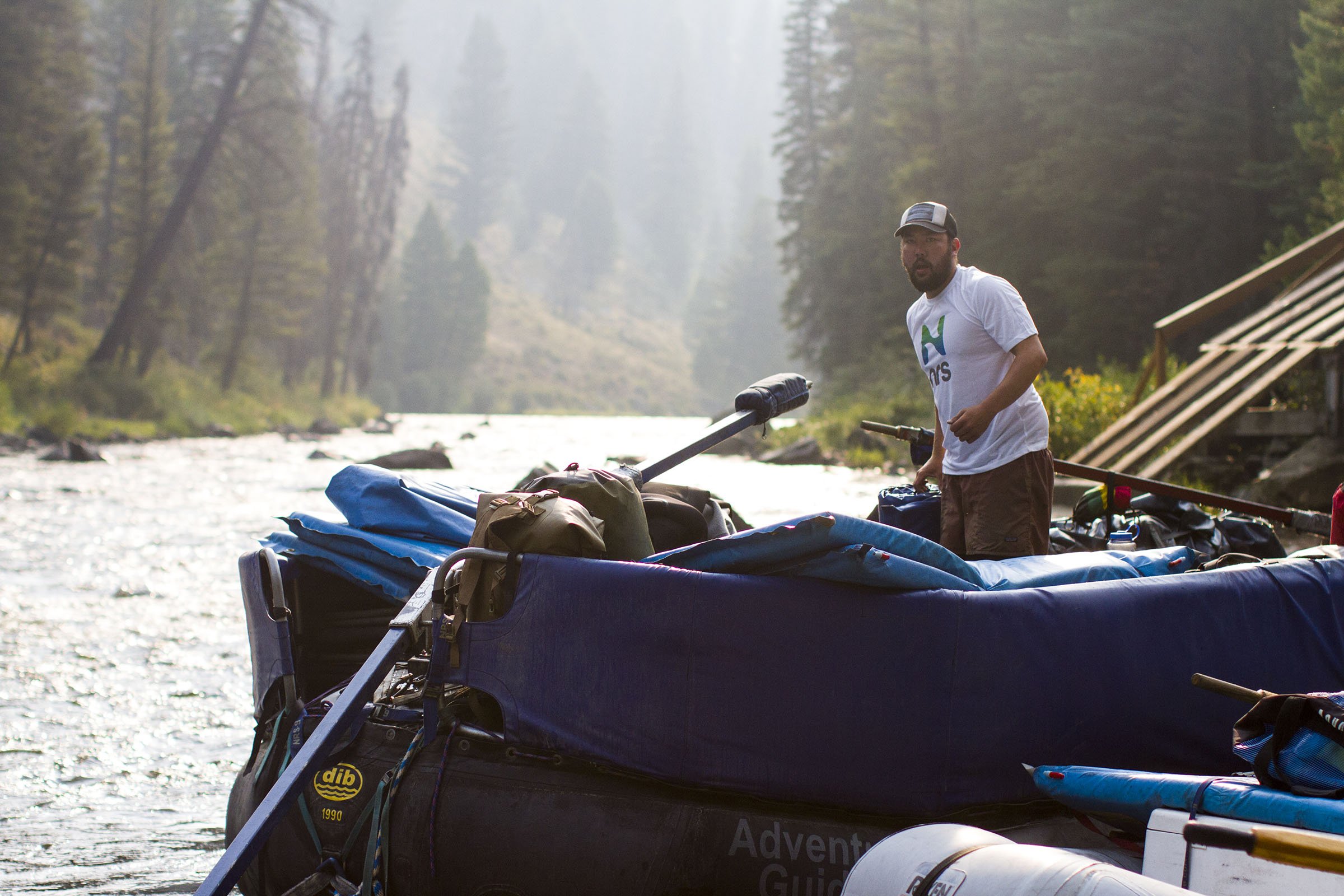
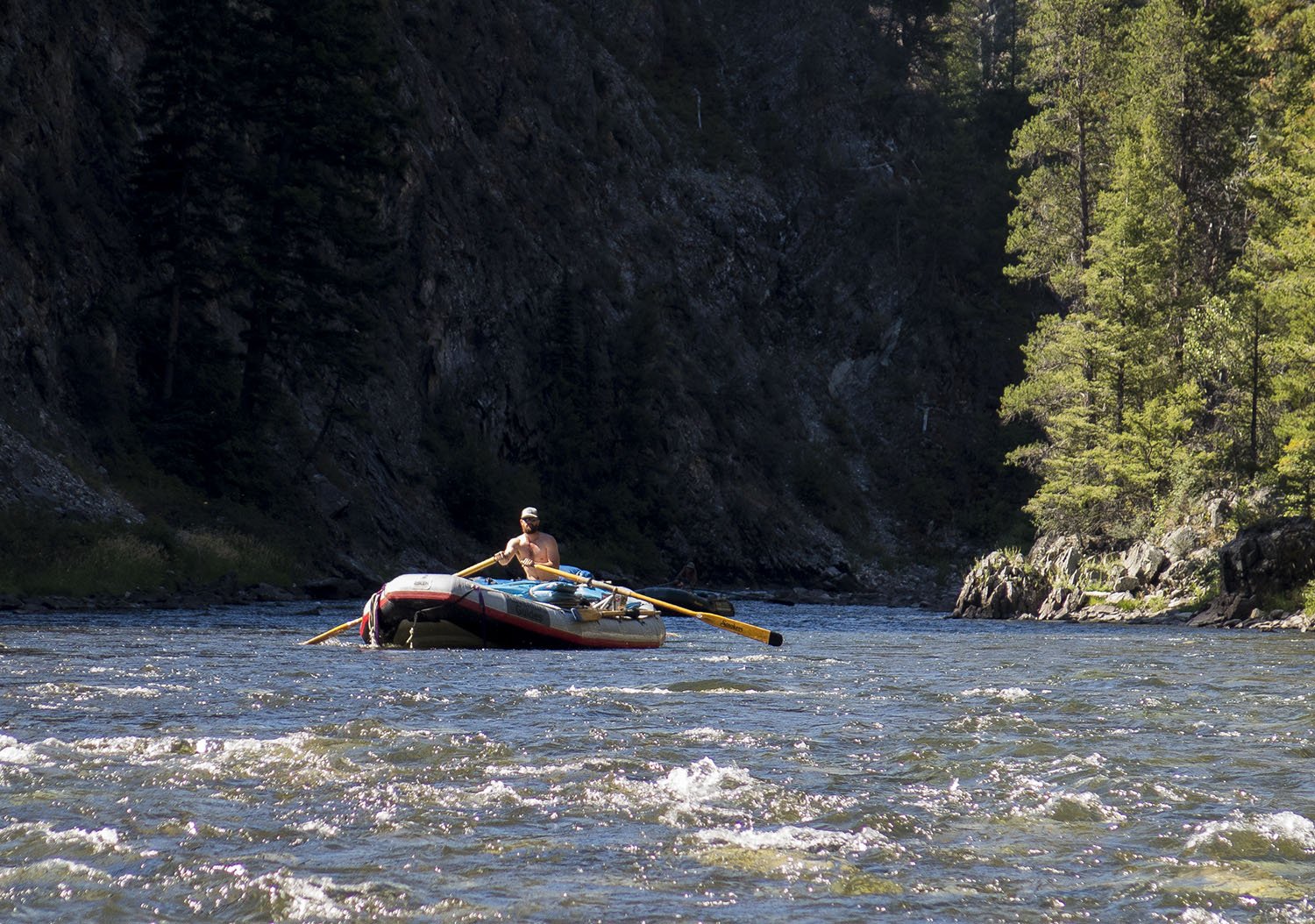
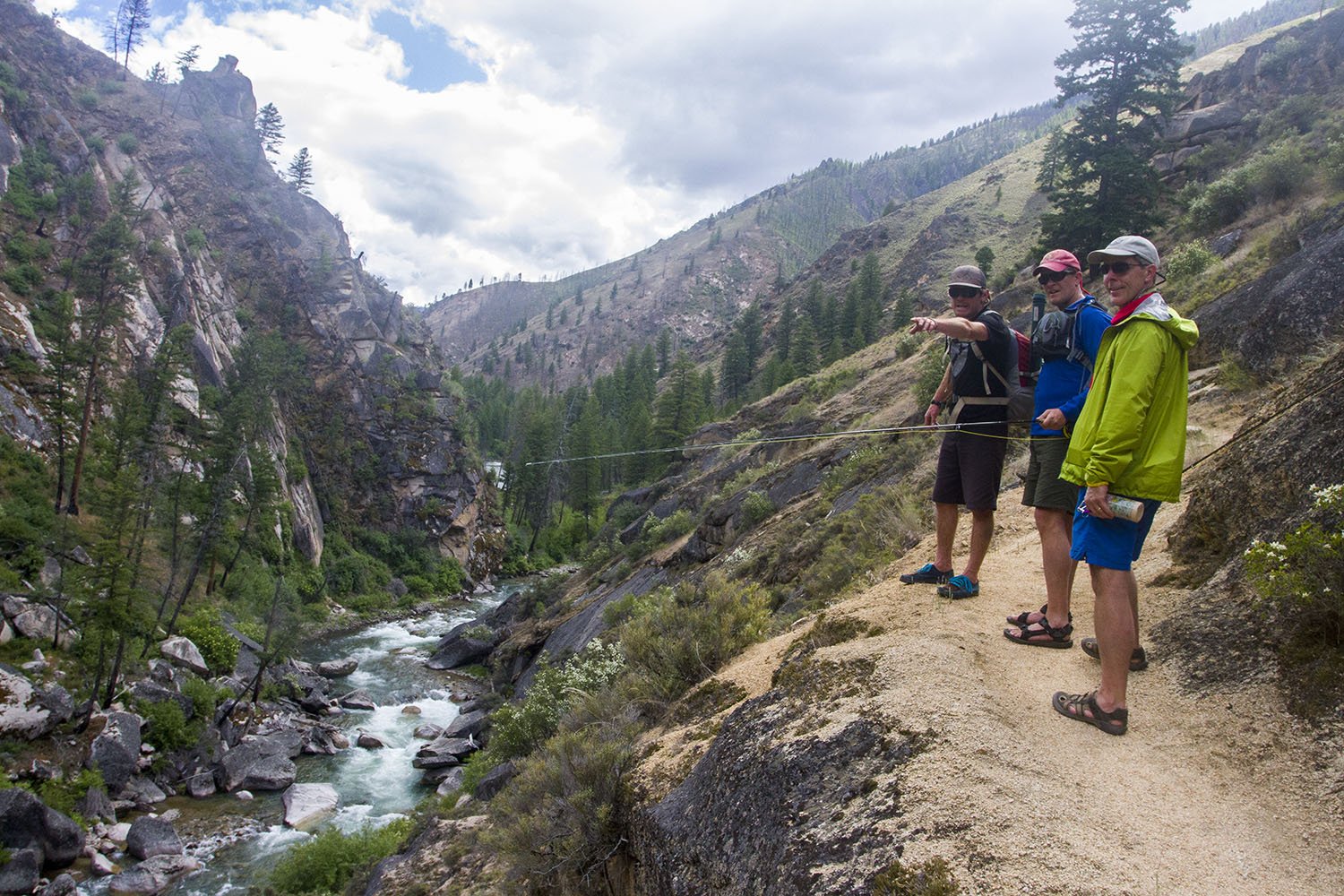
“I will sleep under the stars and be filled with gratitude, forever thankful, for a community and a wild river that has carved its course through my life.”
